
| THE AWARD |
| CATEGORIES |
| REGISTRATION |
| SUBMIT YOUR WORK |
| ENTRY INSTRUCTIONS |
| TERMS & CONDITIONS |
| PUBLICATIONS |
| DATES & FEES |
| METHODOLOGY |
| CONTACT |
| WINNERS |
| PRESS ROOM |
| GET INVOLVED |
| DESIGN PRIZE |
| DESIGN STORE |
| THE AWARD | JURY | CATEGORIES | REGISTRATION | PRESS | WINNERS | PUBLICATIONS | ENTRY INSTRUCTIONS |
Design Rankings Inclusion |
Home > Winner's Pack > Rankings Inclusion |
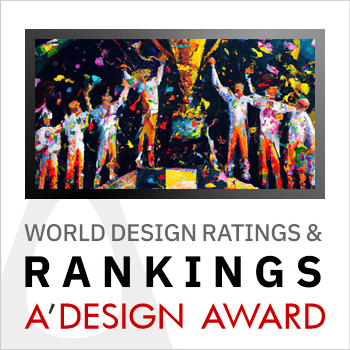 Design Rankings
Design Rankings
A' Design Awards have been publishing and maintaining a series of important ratings and ranking systems for good design, since 2008. In aligned with our mission and vision, the primary aim of these prominent design ranking and rating systems is to recognize, respect and honor award-winning designers for their excellent contributions to the fields of art, design, architecture and design engineering, and ultimately create incentives for the award-winning designers, design agencies and enterprises to create many new good designs that help, benefit and advance society. With yearly campaigns designed around promoting the rankings, and by advertising the ranked designers, the inclusion in the design ranking systems create positive value for the listed designers by providing them with reputation, visibility, discoverability as well as business prospects. A’ Design Awards runs and manages 8 different ranking and rating systems, which are explained in this page. Each ranking and rating system has its own dedicated website as well as deliverables such as infographics, certificates and media materials that are made available to award-winning designers to get most out of their success and participation. Discover and explore designer rankings to see the best of best in each country, each design industry and each time-frame.
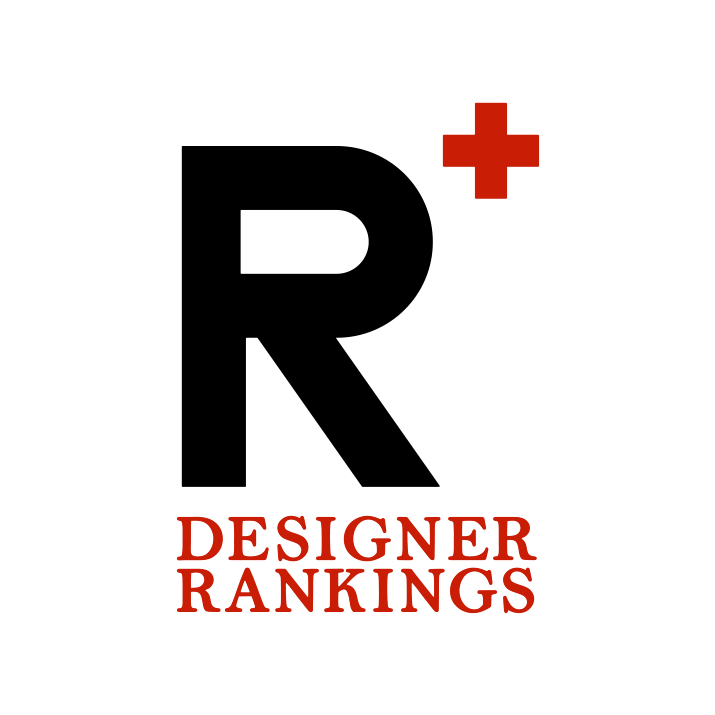
Designer Rankings
The R+ Designer Rankings system is an internationally recognized merit-based system designed by A' Design Award and Competition to rank designers based on the number and caliber of their awards. Winners of A' Design Awards are automatically included and given points according to their award status, with higher prestige awards yielding more points. Additional points are awarded for each subsequent accolade. The purpose of this system is to foster healthy competition among designers, celebrate the top achievers with further distinction, and provide a reliable measure of design quality for businesses, media, and potential clients. The rankings, updated annually, offer significant benefits for ranked designers and their affiliated brands. They enhance the reputation of designers, serve as a powerful marketing tool, increase media coverage, provide new business opportunities, justify premium pricing, boost confidence, create professional networking opportunities, and elevate associated brands' image. Additionally, it assists companies in talent acquisition and offers global exposure to designers. Ultimately, the R+ Designer Rankings system contributes to the global design community by promoting excellence, offering a benchmark for quality, and encouraging a culture of recognition and reward. Further information could be found and the updated rankings could be observed at designerrankings.com Award winners are also able to download the Designer Rankings certificates from their control panels, at Designer Rankings section.
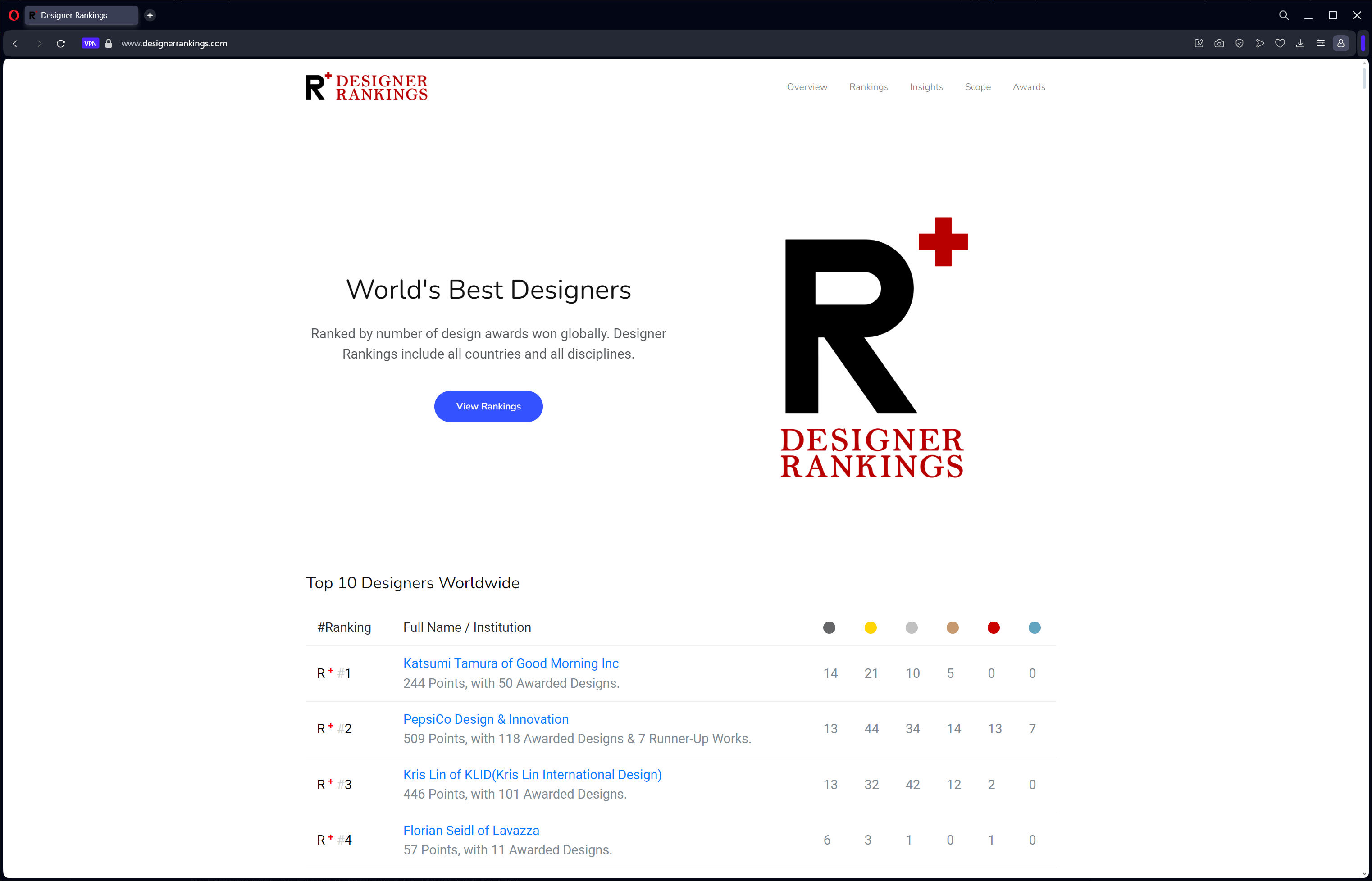
R+ Designer Ranking Certificates and Infographics
A' Design Award and Competition provides complimentary inclusion as well as certificate and infographics to all A' Design Award Winners free of charge. The R+ Designer Rankings Certificates and R+ Designer Rankings Certificates and Infographics provided by A' Design Awards amplify the value of your ranking in a tangible and visually appealing way, enhancing both your physical and digital presence. R+ Designer Rankings Certificates and Infographics serve as crucial tools to effectively communicate your accomplishment and further leverage your status in the industry.
R+ Designer Ranking Inclusion Benefits
Earning a place in the esteemed R+ Designer Rankings serves as a significant professional milestone for designers. R+ Designer Rankings reinforces A' Design Award-winners authority and sets them apart from their peers in the competitive landscape. The R+ Designer Rankings not only attracts potential clients and employers but also doubles as a robust marketing tool. Moreover, high-ranking designers naturally draw media attention, further expanding their reach. R+ Designer Rankings opens the door to more significant business opportunities and justifies premium pricing. When associated with these top-ranked designers, brands see a corresponding enhancement in their image. In detail, here is how R+ Designer Rankings may help you:
- Reputation Enhancement:
Winning the highly regarded A' Design Award enhances a designer's reputation, making them more attractive to prospective clients and employers who value proven excellence. The A' Design Award sets award-winners apart from their competitors, especially in a crowded and highly competitive market. This works because winning a respectful award establishes a designer as a recognized expert in their field. In a sense, this recognition is a form of social proof, a psychological and social phenomenon where people assume the actions of others in an attempt to reflect correct behavior for a given situation. By demonstrating that a designer's work is highly valued by a respected authority - the A' Design Awards where entries are voted by a grand jury panel on pre-established evaluation criteria following blind peer-review process, potential clients may be more inclined to trust and choose them over non-awarded competitors.
- Marketing Tool:
Being ranked on R+ Design Rankings platform gives designers and brands a powerful marketing tool. A' Design Award winners can use this recognition in their promotional materials, on their websites, and in pitches to clients. Including the A' Design Award in marketing materials leverages the Authority Principle, which states that people respect authority and are more likely to follow it. When designers advertise their high ranking, they project authority in their field, which can influence potential clients' decision-making.
- Media Coverage:
High-ranking designers on the R+ Designer Rankings are more likely to receive media attention. The publicity can further enhance their reputation and visibility, leading to more opportunities. Media outlets prefer to cover stories that draw readers' interest. Top-ranked designers inherently have a "newsworthiness" due to their achievements. This results in greater media exposure, which is essentially free advertising with a potentially large reach.
- Business Opportunities:
Businesses looking for top-tier design talent may use R+ Designer Rankings as a starting point, leading to more job and collaboration opportunities for the ranked designers. This works because businesses aim to reduce risk when choosing designers for their projects. A' Design Award-winning designers have a proven track record of success, which decreases perceived risk. This is essentially the business concept of risk management applied to the hiring process.
- Increased Pricing Leverage:
Designers with a high R+ Designer Ranking can justify charging more for their services, as they have objective proof of their competence and talent. In economics, this can be related to the concept of value-based pricing, where products or services are priced based on their perceived worth. A' Design Award-winning designers can charge more due to the perceived value they bring, as long as they communicate their worth properly, and the R+ Designer Rankings help communicate their value as a high-ranking designer.
- Boosts Confidence:
The inclusion in R+ Designer Rankings provides further recognition which boosts the confidence of the designers and validates their work, which can spur them on to take on more challenging projects. Winning the A' Design Award acts as an external validation of the designer's skills. This aligns with the concept of self-efficacy from psychology, which is the belief in one's abilities to succeed in specific situations, which can also help create a positive self fulfilling prophecy, which in return could help you gain even higher success.
- Professional Networking:
R+ Designer Rankings can create networking opportunities with other high-ranking designers, potentially leading to collaborations and idea-sharing. The rankings provide a platform for designers to have a ground to connect, opening opportunities for collaboration. This plays into the idea of networking economies, where the value of a product or service increases with the number of others using it.
- Brand Association:
For brands that employ or collaborate with high-ranking designers within R+ Designer Rankings, the association with top designers can enhance their brand image and market position. Brands collaborating with high-ranking designers benefit from the Halo Effect, a cognitive bias where the perception of one quality (designer's ranking) influences the perception of other qualities (brand's product or service quality).
- Talent Acquisition:
R+ Designer Rankings could serve as a reliable source for companies seeking to hire top talent in design and architecture. As per the principal-agent problem in economics, employers (principals) struggle to judge the quality of potential employees (agents). The rankings serve as a reliable measure of quality, simplifying the hiring process. A' Design Award already reaches design oriented media who are able to easily understand the quality of your work, however, this particular principle may help you gain further recognition especially from non-design media, such as national publications who may not be as adept as design oriented media in identifying best designers, here winning the A' Design Award clearly communicates the quality and excellence of your work.
- Global Exposure:
For architects and designers, particularly from less well-known regions or markets, the global exposure of being included in R+ Designer Rankings could significantly enhance their career prospects. The R+ Designer Rankings amplify a designer's reach globally, facilitating cross-border collaborations and tapping into global markets.
R+ Designer Rankings Methodology
R+ Designer Rankings system ranks all the designers that have been granted with the A' Design Award, but also counts the runner-up status designs as single points. Designers are further granted 2 to 6 additional points for each award they have won. Designers with the highest score are displayed first; i.e. designers are ranked based on the award status points. Within this perspective, winning a Platinum A' Design Award could be considered equal to winning three A' (Iron) Design Awards. The listing includes all years; therefore it is usually observed that even the top designers' positions fluctuate yearly. Winners usually share their information regarding the rankings through press releases and announcements. A' Design Award and Competition also makes a distinct press release and campaign each year to announce the designer rankings, and to promote the highest ranking designers. The aim of the Designer Rankings is to spur competition among participants and to award the highest ranking winners once again by celebrating them with a different title.
Through the R+ Designer Rankings, part of the A' Design Prize, we uplift and honor excellent designers whose superior designs advance society and make the world a better place. The R+ Designer Rankings not only shine a spotlight on individual talent but also foster an environment where good design is appreciated and sought after. We firmly believe in celebrating and promoting good designers, as it aligns with our core mission to make the world a better place through good design.
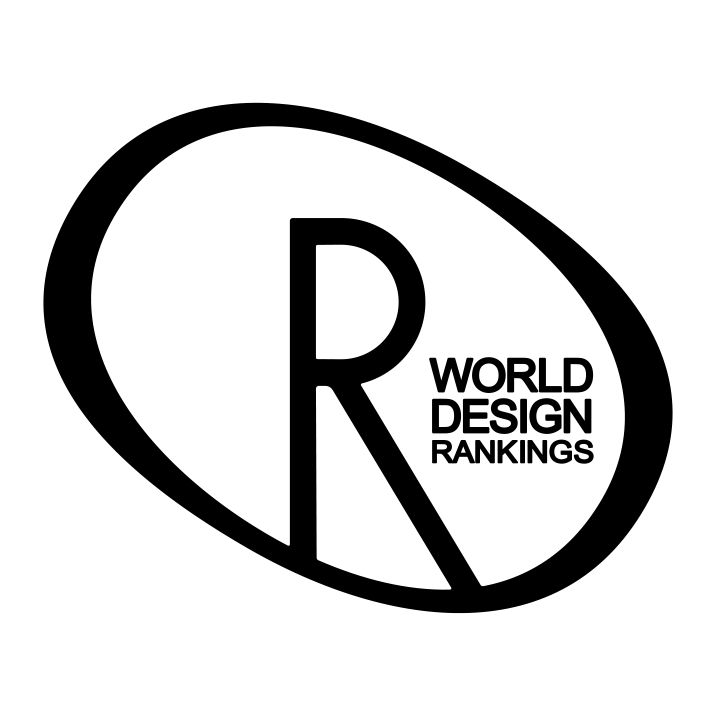 World Design Rankings
World Design Rankings
World Design Rankings (WDR) is an international platform that assesses and ranks countries based on the number of A' Design Award recipients, serving as a robust measure of design excellence across the globe. The A' Design Awards allocate points to winners depending on their award level, and these points contribute to a country's ranking in WDR. Recognized worldwide, this ranking enhances the credibility and visibility of participating designers, fostering global recognition, client trust, and a competitive edge. Through inclusion in WDR, designers and design brands can leverage promotional opportunities, attract media coverage, expand their client base, and boost their brand image, potentially leading to higher service rates. Moreover, the platform facilitates networking, partnerships, and cultural exchange within the global design community, encouraging cross-cultural collaborations and fostering innovative design approaches. WDR also has wider societal impacts, as high-ranking designers can stimulate local design industries, influence policy decisions, boost cultural tourism, and increase the demand for design education. Thus, World Design Rankings not only propel individual and corporate growth in the design industry, but also contribute significantly to the cultural, economic, and educational development of their respective countries. Further information could be found and the updated world design rankings could be observed at worlddesignrankings.com
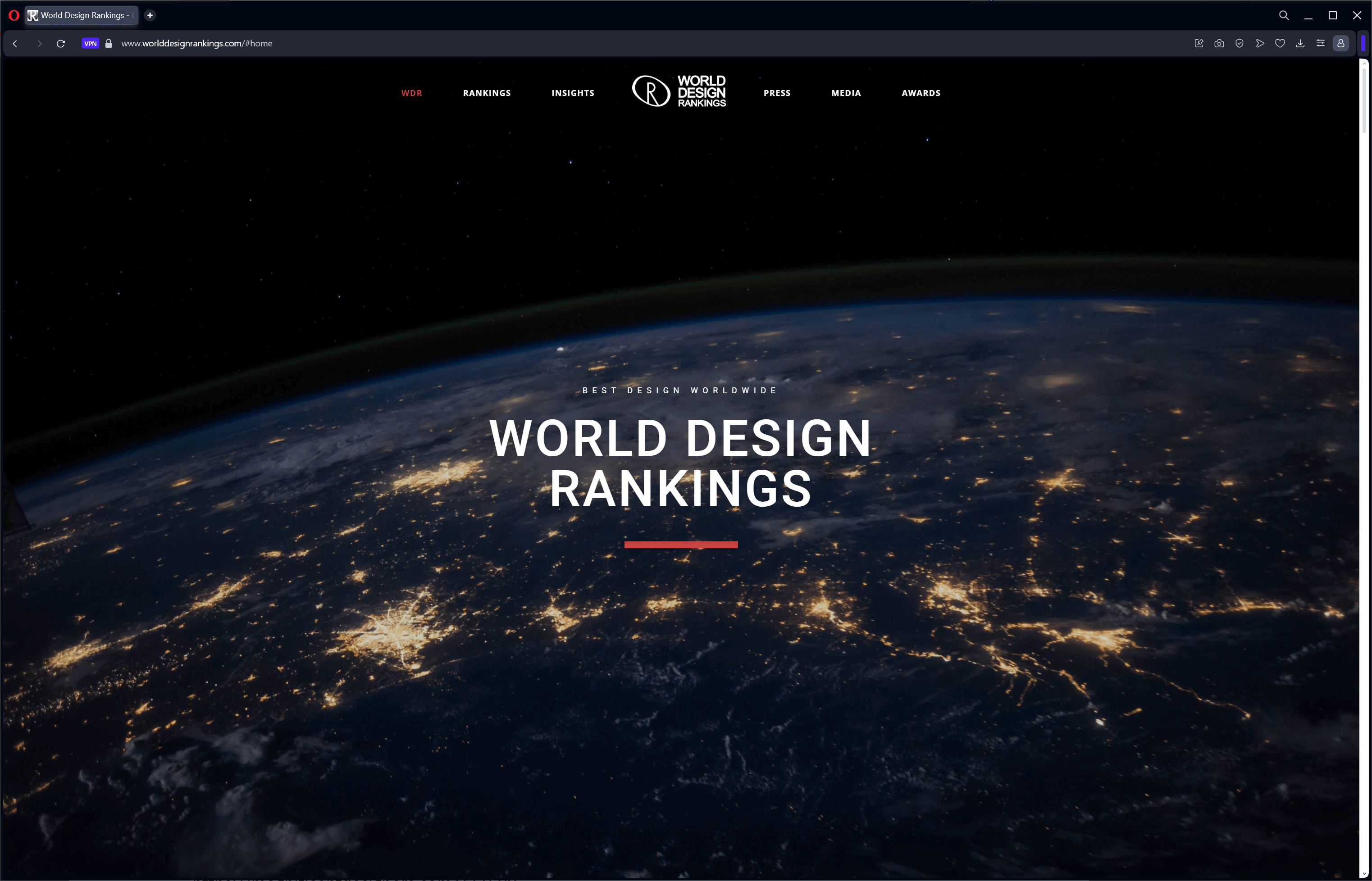
World Design Ranking Certificates and Infographics
A' Design Awards offers free certificates and infographics to its award winners, serving as tangible evidence of their achievements in the World Design Rankings. These materials not only enhance professional credibility and provide visual representations of the winners' success but also function as powerful marketing assets and social proof of their capabilities. These tools underline the global recognition garnered through these awards, differentiating designers on a worldwide platform, thus aiding in reputation building within the design industry. It is highly advantageous for winners to utilize these resources for promotional purposes.
World Design Rankings Inclusion Benefits
World Design Rankings (WDR) serves as a valuable platform for recognizing and promoting design excellence globally. It provides numerous benefits to the design community, including but not limited to Global Recognition, Credibility and Trust, Increased Client Base, Brand Image Boost, Competitive Advantage, Increased Value of Services, Media Coverage and Promotional Opportunities among others. World Design Rankings not only highlights the hard work and talent of individual designers and firms but also promotes the growth and importance of the design industry on a global scale. WDR provides the design community with an exceptional platform for exposure, networking, learning, and growth.
- Global Recognition:
Being featured on World Design Rankings can provide worldwide recognition for a designer's work. This can elevate their reputation and brand visibility globally. World Design Rankings ranks designers based on the prestigious A' Design Award. These awards are recognized worldwide, hence the listing inherently gives designers a global platform. The concept of "social proof," a psychological phenomenon where people imitate the actions of others in an attempt to reflect correct behavior, plays a role here as people tend to be attracted to and trust what is already approved by others.
- Credibility and Trust:
An award from a prestigious competition like A' Design Award adds credibility to the designer, architect and brand, making potential clients more likely to trust and hire them for their services. Being recognized by World Design Rankings indicates a designer's competence, quality, and expertise, thus enhancing their credibility. According to the "halo effect," a cognitive bias where an observer's overall impression of a person influences their feelings and thoughts about that person's character, a designer's credibility can influence clients' perception of their work positively.
- Increased Client Base:
World Design Rankings could help designers and brands to reach a global audience. This can increase the pool of potential clients. The internet has made the world a global village. World Design Rankings, being a global platform, provides designers with exposure to potential clients from all corners of the world, hence increasing their client base. This benefit is a direct consequence of the principles of globalized markets and digital economy.
- Brand Image Boost:
Being ranked among the best in the world could significantly enhance a designer's or brand's image, positioning them as leaders in their respective fields. Being listed at World Design Rankings enhances a brand's image and creates a distinct brand identity, essential for differentiating from competition. This can be understood through "brand positioning," a marketing strategy that aims to make a brand occupy a distinct position in the mind of the customer.
- Competitive Advantage:
Having a prestogopis international award and getting listed in World Design Rankings among the top of the world can give designers and brands a competitive edge in the market. In a highly competitive market, unique differentiators are key. Recognition by World Design Rankings provides an edge over competitors, making a designer's services more desirable. This concept aligns with Porter's "competitive advantage theory" which suggests that certain types of competitive advantages can lead to long-term success.
- Promotional Opportunities:
World Design Rankings offers an excellent platform for self-promotion. Designers can use their ranking in their marketing and advertising materials, on their websites, and across their social media channels. Featuring in World Design Rankings can be used as a strong selling point in promotional activities. It provides proof of expertise and quality, leveraging the principle of "authority," where people tend to obey authorities in their field. A' Design Awards provides infographics and certificates to support self-promotion activities.
- Media Coverage:
Media outlets are often attracted to success stories and getting featured at World Design Rankings is relevant to both local as well as international media. Media outlets may be more inclined to cover designers and brands that have received international recognition, leading to further exposure. Being ranked among the top in World Design Rankings is a compelling narrative that could attract media attention, increasing visibility and reputation through the amplifying effects of mass media. The World Design Rankings, being a reputable platform, can attract the attention of media outlets and journalists who are interested in featuring the top designers and brands representing their countries. This can lead to extensive media coverage and interviews, further boosting visibility and generating positive publicity.
- Networking Opportunities:
Being featured on World Design Rankings can open up networking opportunities with other top-ranked designers, potential collaborators, and clients from around the world, especially when and if you attend the A' Design Award and Competition's La Notte Premio A' - The Gala Night and Award Ceremony and the follow up Ars Futura Cultura meetings. High-profile platforms like World Design Rankings are likely to attract industry leaders, enabling networking opportunities which can lead to collaborations and partnerships. This benefit arises from the principles of networking and social capital.
- Partnership and Collaboration Opportunities:
Companies often seek out high-ranking designers and architects for collaborations, partnerships, or endorsements, creating new business opportunities.High-ranking individuals or companies are often sought after for partnerships. Collaborating with a World Design Rankings-ranked designer could be a strategic move for companies looking to leverage the designer's reputation for their own branding, explained by the concept of "brand association." as well as "co-branding".
- Increased Value of Services:
With true global recognition provided by the A' Design Awards and inclusion in the World Design Rankings, designers and architects can justify charging higher rates for their services. Recognition by World Design Rankings can justify higher rates for their services due to the perceived increase in value, which laureates can communicate effectively with WDR Certificates and Infographics.
- Cultural Exchange:
A platform like World Design Ranking encourages interaction between designers from different cultures, potentially leading to innovative, cross-cultural design collaborations.As a global platform, World Design Rankings brings together designers from different cultural backgrounds, fostering cultural exchange and diversity. This could spark innovative ideas, backed by the concept of "creative abrasion" where conflict and diversity lead to creative solutions.
- Global Design Trends:
By observing other top-ranked designers in the World Design Rankings, one can gain insights into emerging global design trends and incorporate them into their own work. Being in World Design Rankings could provide insider perspective and insights into global design trends, essential for staying relevant. This follows the economic principle of "market orientation" where understanding market trends and customer needs are key to success.
- Inspiration for Future Projects:
The World Design Rankings platform can serve as a rich source of inspiration, sparking new ideas for future designs. The variety of designs showcased on World Design Rankings can serve as a source of inspiration, enabling designers to come up with unique ideas, a phenomenon known as "idea cross-pollination."
- Attracting Talent:
Brands High-ranking in the World Design Rankings may find it easier to attract and retain top talent, who would want to work with a globally recognized company. Featuring in World Design Rankings can help you attract more talent to your enterprise. Successful brands tend to attract talent. The "attraction-selection-attrition theory" suggests that individuals are attracted to organizations where they will fit in, based on their personalities and values.
- Social Influence:
Successful designers high-ranking in World Design Rankings can use their status to champion social causes, leveraging their influence to make a difference. Being in World Design Rankings could help you exert social influence. High-ranking designers have a platform to influence societal issues, supported by the "theory of social influence," where individuals change their behavior to meet the demands of a social environment.
- Educational Opportunities:
Designers listed in the World Design Rankings can learn and refine their skills by observing top-ranked counterparts, a concept rooted in "observational learning" theory. World Design Rankings listed designers, architects and brands have the opportunity to engage with and learn from their counterparts in other countries, improving their own skills and techniques, especially by taking part in events and meetings organized by the A' Design Awards.
- Encouraging Local Design Industries:
Success on an important international stage such as the World Design Rankings can inspire other designers in their home country, boosting the local design industry. Successful designers, listed highly in World Design Rankings, can inspire and stimulate the growth of local design industries. The "demonstration effect" suggests that people tend to emulate the success of others, leading to industry growth. High-ranking World Design Ranking designers and brands can lead design initiatives in their country and industry.
- Tourism Boost:
High-ranking successful designers, architects and artists listed at the World Design Rankings might attract design enthusiasts to their home countries, boosting local tourism within the scope of "cultural tourism" theory. Especially designers, with high rankings in World Design Rankings, could attract tourists interested in their work, boosting local tourism by means of their design exhibitions, workshops and events. A' Design Award and Competition helps organization of 40 × 40 design exhibitions to help with this cultural tourisim in addition to other high level initiatives such as the Prime Design Hub, specifically designed to boost cultural tourism.
- Increased Demand for Design Education:
Countries with high-ranking designers might see an increased interest in design education, leading to the development of more and better design schools. Successful designers can inspire others in their country, as well as the world, to pursue design, leading to a demand for better design schools. This could be attributed to the "role model effect" where successful individuals inspire others to follow their path.
- Policy Influence:
Success on the world stage, getting listed in World Design Rankings, can influence local and national policies, encouraging governments to invest more in the creative sector. Successful designers can influence policy-making to favor the design industry in their countries. This aligns with the "public choice theory," where policy decisions are influenced by various interest groups.
- Inspiration and Motivation:
The World Design Rankings can inspire designers and brands to strive for excellence and push the boundaries of their creativity. It can serve as a motivation to continuously improve their work and stay at the forefront of the design industry. The mere fact of representing your country in the World Design Rankings, is a respected honor, an esteemed achievement to be proud of.
World Design Rankings Methodology
WDR World Design Rankings ranks all the countries based on the number of designers that have been granted with the A' Design Award. The displayed rankings are based on the aggregated scores of participants between all competition years. A’ Design Award & Competition provides a heat map of countries on the world map, and a special distinct press release for the updated world design rankings each year. For World Design Rankings, each winner gets the following points: Platinum A’ Design Award 6 Points, Golden A’ Design Award 5 Points, Silver A’ Design Award 4 Points, Bronze A’ Design Award 3 Points and Iron A’ Design Award 2 Points. Runner-Ups not included. World Design Rankings are usually featured in the media, and works great as a communication tool. Many winners do announce their contributions to the rankings through press releases or mentions. A’ Design Award & Competition makes a distinct press release for World Design Rankings each year and a communication campaign is run at different media to highlight the importance of the rankings. A certificate for World Design Rankings is available to A' Design Award winners. The aim of the World Design Rankings is to foster competition among countries, and to create further awareness for design.
The World Design Rankings offer significant benefits to A' Design Award winners, their countries, and the global design industry. By recognizing and promoting exceptional design talent, the rankings help fulfill the A' Design Award's mission of making the world a better place through good design. This international platform stimulates a greater appreciation for good design and a more nurturing environment for designers to thrive. We're proud to contribute to this mission, celebrating the creative minds who advance society with their superior designs.
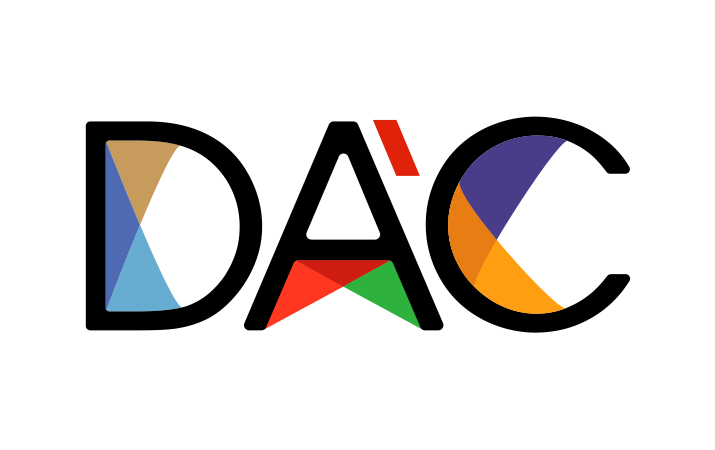 Design Classifications
Design Classifications
The DAC - Design Classifications is a prestigious platform that ranks designers across various categories based on the points they earn from A' Design Awards. It serves as a definitive guide for highlighting top designers in each category, thereby assisting high-profile companies and editors in identifying leading creative talents for their needs. For award-winning designers, DAC inclusion offers increased visibility, recognition of excellence, improved negotiating power, and numerous other professional advantages, while simultaneously amplifying their influence on industry trends, design education, and social impact. For society at large, it fosters a high standard of design, promotes socially conscious and problem-solving design approaches, and contributes to the appreciation of design's role in addressing global issues. Learn more and see the latest standings at designclassifications.com
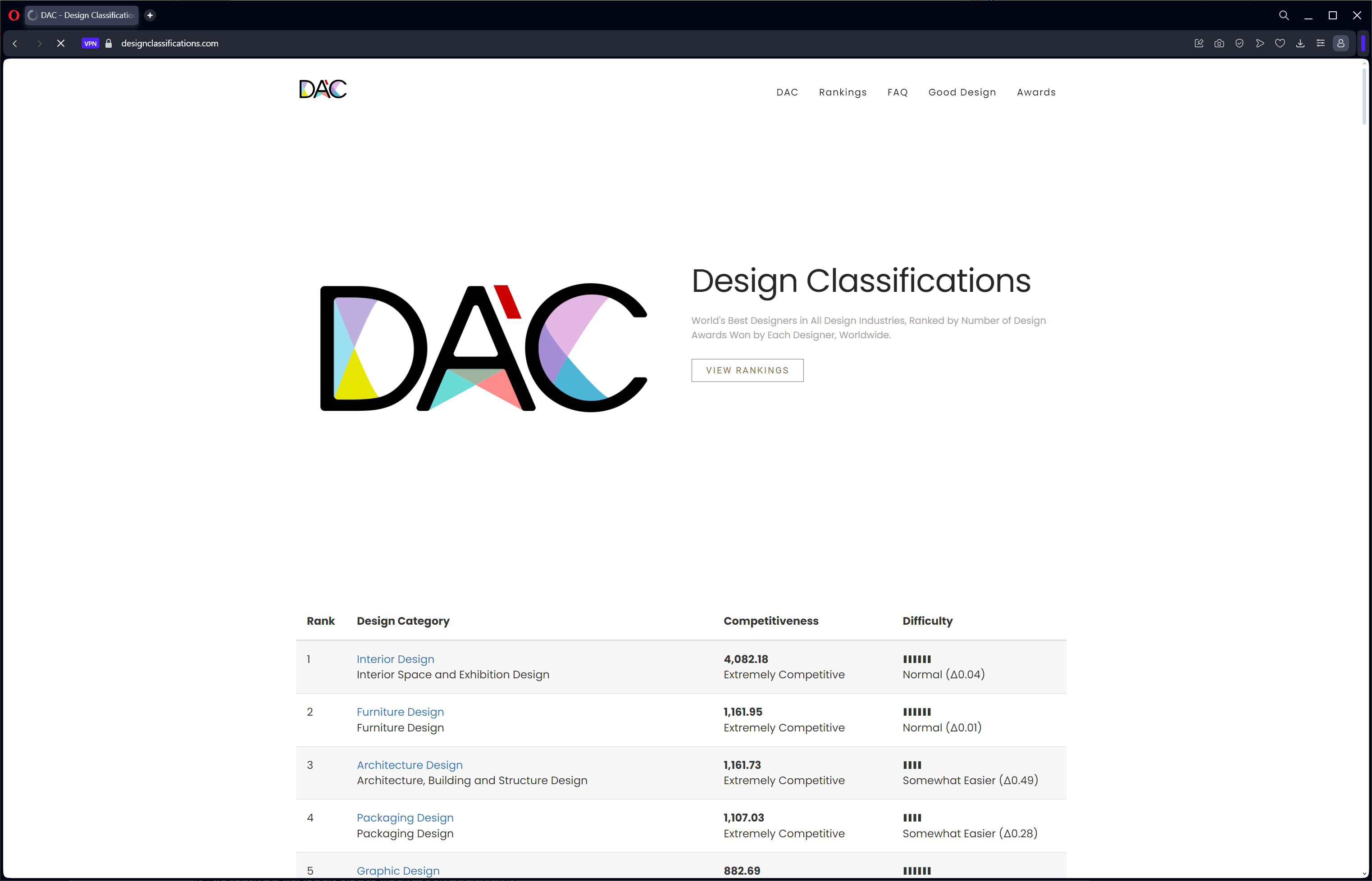
Design Classifications Ranking Certificates and Infographics
The A' Design Award provides complimentary certificates and infographics for DAC - Design Classifications rankings. These DAC Certificates and Infographics are valuable tools that serve as legitimate proof of achievement, enhance branding, amplify marketing efforts, and can attract media attention. In addition, these visually compelling materials enable effective communication of the award-winner's recognition to a broad audience, while also providing a rewarding, tangible representation of their accomplishment. Hence, these assets, when used strategically, can significantly elevate the award-winner's reputation, visibility, and differentiation in a competitive industry.
Design Classifications Platform Inclusion Benefits
Inclusion in the DAC - Design Classifications provides award-winning brands and designers with increased visibility and recognition of excellence, while amplifying marketing efforts and attracting media exposure. It enhances their negotiating power and enables them to be part of an elite peer network. High-ranking DAC participants can access exclusive opportunities, attract more business collaborations, and gain a competitive edge in the market. They can boost consumer trust, attract top talent, stay updated with industry trends, and feel motivated by the professional acknowledgment. The DAC inclusion aids in brand storytelling, offers educational value, encourages a problem-solving design approach, and promotes social impact. Overall, it contributes to improved job satisfaction, general wellbeing, and fosters a continuous cycle of creativity and productivity.
- Increased Visibility:
Being listed on the DAC - Design Classifications platform means a designer or architect's work can be seen by more people, boosting their professional profile. Visibility in any industry is crucial to gaining traction. When a designer is listed on the DAC platform, they're exposed to a wider audience, potentially including industry professionals, clients, and enthusiasts. This visibility is amplified by the inherent authority of the DAC platform, which only showcases award-winning designers. This situation relates to the concept of "Social Proof" in psychology, where people tend to trust and follow what has already been approved or endorsed by others.
- Recognition of Excellence:
The points system used by DAC - Design Classifications rankings platform rewards quality and consistent design work. This recognition can enhance the reputation of the designer, architect or brand, establishing them as leaders in their field. The DAC platform employs a points system tied to the A’ Design Awards, well-known for recognizing excellence in design via meritocratic evaluation. This publicly visible ranking acts as a signal of quality, similar to how in economics, a brand with high reputation can signal high quality.
- Marketing Advantage:
Being ranked as a top designer in their category can be used in marketing materials and pitches, reinforcing credibility and demonstrating their success to potential clients. The DAC ranking can be used as a key differentiator in marketing materials. Businesses often use unique selling propositions (USPs) to stand out, and your DAC ranking can serve as a compelling USP. In the context of the signaling theory, a high DAC ranking signals a designer's capability to potential clients.
- Media Exposure:
Designers ranked highly in the DAC - Design Classifications rankings platform are more likely to attract media attention, leading to potential interviews, features, and articles that can further boost their reputation and visibility. Journalists and reporters often look for noteworthy topics and high achievers to feature in their stories. Being listed as a top designer in DAC rankings can trigger interest from the media, leading to additional publicity, following the "newsworthiness" concept in journalism.
- Positive Influence:
Top designers listed in DAC - Design Classifications, by virtue of their high visibility and reputation, can play a significant role in shaping the direction of their respective fields. Their approach to design, their innovations, and their commitment to excellence can inspire other designers and influence trends and standards in the industry. This is similar to the concept of 'thought leadership', where individuals or firms that are recognized as authorities in their specialized field are sought after for their expertise and insights.
- Improved Negotiating Power:
A high DAC ranking also provides designers with greater negotiating power. With their skills and excellence being formally recognized, designers can confidently command higher fees and better terms for their work. This is related to the economic concept of 'bargaining power', which refers to the ability of a party to influence the terms of a transaction in their favor.
- Peer Network:
Being a part of the DAC - Design Classifications platform allows designers to be a part of a network of elite professionals from around the world. This network can provide valuable insights, support, and collaborations that can further enhance a designer's career. The platform essentially creates a community of top-performing designers, each bringing their unique perspective, experience, and skill to the collective. This can result in valuable opportunities for professional growth and collaboration. It's a concept similar to the 'network effect' in economics, where the value of a product or service increases as more people use it. Designers ranked highly in the DAC are invited to join the World Design Consortium.
- Access to Opportunities:
High-ranking designers on the DAC - Design Classifications platform may have access to exclusive opportunities, such as special projects, collaborations, or competitions. This not only provides additional avenues for showcasing their skills but also exposes them to new challenges and learning experiences. This concept relates to the 'Matthew Effect' in sociology, which suggests that those who already have status or resources are often in the best position to receive more.
- Business Development:
Companies looking for top design talents are likely to consult the DAC - Design Classifications rankings. A high rank can lead to more business opportunities and collaborations. In the B2B market, businesses look for reliable partners. A DAC ranking acts as a trust signal, reducing the perceived risk in business transactions. This is linked to the concept of "information asymmetry" in economics, where one party (the hiring company) lacks complete information about the other party (the designer). DAC assists in this by providing guidence to hiring companies regarding capabilities of the designers, making the designers listed highly at DAC more trustable.
- Competitive Edge:
Ranking highly in the DAC - Design Classifications gives a designer a competitive advantage over others in the industry, potentially leading to more opportunities and higher fees. In a saturated market, differentiation is key. A high DAC ranking offers a unique advantage over competitors. This ties into Porter's "Differentiation Strategy" in business, which focuses on distinguishing a company's offerings with unique qualities.
- Consumer Trust:
For brands, being associated with a top-ranked designer, listed highly in the DAC - Design Classifications, can boost consumer trust and positively impact sales. In the psychology of persuasion, authority is a key principle. Brands associated with top-ranked designers can increase their perceived authority, thus enhancing consumer trust.
- Talent Attraction:
High-ranking designers and firms in the DAC - Design Classifications platform can attract talented professionals looking to work with the best in the industry. Being a top-ranked designer or firm can attract skilled professionals who want to work with the best, similar to how prestigious universities attract top students. This can be explained by the "halo effect" where positive impressions in one area (DAC ranking) influence positive perceptions in another (workplace quality).
- Industry Trends:
By following DAC - Design Classifications rankings, designers can stay up-to-date with industry trends and continually adapt and grow. Regularly observing the DAC rankings can help designers stay current and relevant. In business terms, this is akin to environmental scanning, a process of gathering and analyzing information about an organization's external environment.
- Intrinsic Motivation:
Designers are often driven by a desire to create and innovate. Seeing their names rise in the DAC - Design Classifications rankings can provide a satisfying measure of their creative growth. A rise in DAC ranking can bolster a designer's intrinsic motivation, which is the internal drive to perform well. Self-Determination Theory in psychology explains that such internal rewards can enhance creativity and productivity.
- Brand Storytelling:
The journey to achieving a high DAC - Design Classifications rank can be used as a compelling narrative in brand storytelling. A compelling narrative can make a brand more relatable and memorable. As per the "Narrative Paradigm" in communication theories, humans are inherently storytellers, and they are more likely to be persuaded by compelling narratives.
- Design Education:
Observing the best designers at the DAC - Design Classifications can provide educational value to up-and-coming designers, fostering the next generation of design talent. By observing the work of fellow top designers on the DAC platform, other designers may foster continued growth, and by ranking highly on the DAC - Design Classifications, you can inspire the next generation of design talent as well as design trends.
- Mindset Shift:
The competition and desire to rank highly in the DAC - Design Classifications could encourage designers to shift their mindset from simply designing to creating with an intention to solve real-world problems. The competitive nature of DAC - Design Classifications ranking could push designers to go beyond aesthetics, especially considering the fact that Platinum and Gold level achievements which provides the most points are evaluated on factors beyond mere aesthetics, and thus push the designers to design with a purpose - solving real-world problems. This shift can bring more meaningful impact through good design.
- Social Impact:
High visibility on the DAC - Design Classifications platform allows designers to draw attention not only to their individual talents but also to broader concerns of sustainability and social consciousness within the design field. As a result of the prestige associated with this platform, the designers' approach towards their craft has the potential to influence design standards across the board, pushing for a more socially and environmentally conscious industry. This visibility could initiate dialogues around the role of design in social and environmental matters, helping to reframe the way design is perceived and appreciated in the broader context of global issues.
- Wellbeing and Satisfaction:
The recognition accorded by the DAC - Design Classifications doesn't merely pertain to the professional realm. Its positive impacts extend to the personal level as well, with improved job satisfaction, increased self-esteem, and general wellbeing being notable side-effects. As designers see their hard work, passion, and creativity being acknowledged on a prestigious platform, the sense of fulfillment derived from this recognition provides a powerful intrinsic motivator. This recognition could contribute to a healthier work-life balance and spur continued creativity and productivity, reinforcing a positive feedback loop between professional accomplishment and personal satisfaction.
Design Classifications Methodology
DAC Design Classifications ranks all the designers in a specific design category, for example you could learn who are the very best furniture designers, the best architects or fashion designers. The DAC - Design Classifications platform rankings is category based. The DAC - Design Classifications ranking is aimed to highlight the very best designers in each category. For DAC Design Classifications, each winner gets the following points: Platinum A’ Design Award 6 Points, Golden A’ Design Award 5 Points, Silver A’ Design Award 4 Points, Bronze A’ Design Award 3 Points and Iron A’ Design Award 2 Points. A certificate for Design Classifications is available to A' Design Award laureates.
The Design Classifications, as part of the A' Design Prize, is not just a testament to a designer's excellence, but also a powerful tool that benefits society at large. By promoting award-winners via Design Classifications, we aim to foster a global appreciation for good design and create an environment that nurtures design innovation. The recognition and exposure offered by the DAC facilitate a deeper understanding of design's work and their good design.
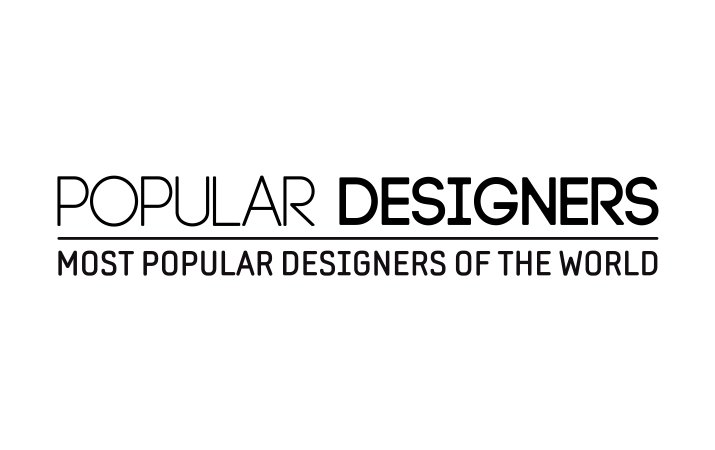 POPDES Popular Designers
POPDES Popular Designers
POPDES - The Popular Designers platform is a popularity-based ranking offered by A' Design Awards, which measures and promotes the visibility and influence of designers based on several factors such as press member views, designer profile views, and design views.The system also considers the likes and interests from other users, impressions, visualizations, search volume, and trends. It's a great tool for designers to showcase their popularity and marketability, helping them to attract clients, justify pricing, enhance their reputation, network with others, attract investors and endorsements, validate their market acceptance, attract talent, boost crowdfunding campaigns, and even earn influencer status. A' Design Awards offers free POPDES certificates and infographics to acknowledge designers' achievements and promote their popularity rankings. Learn more and see the latest standings at popdes.com
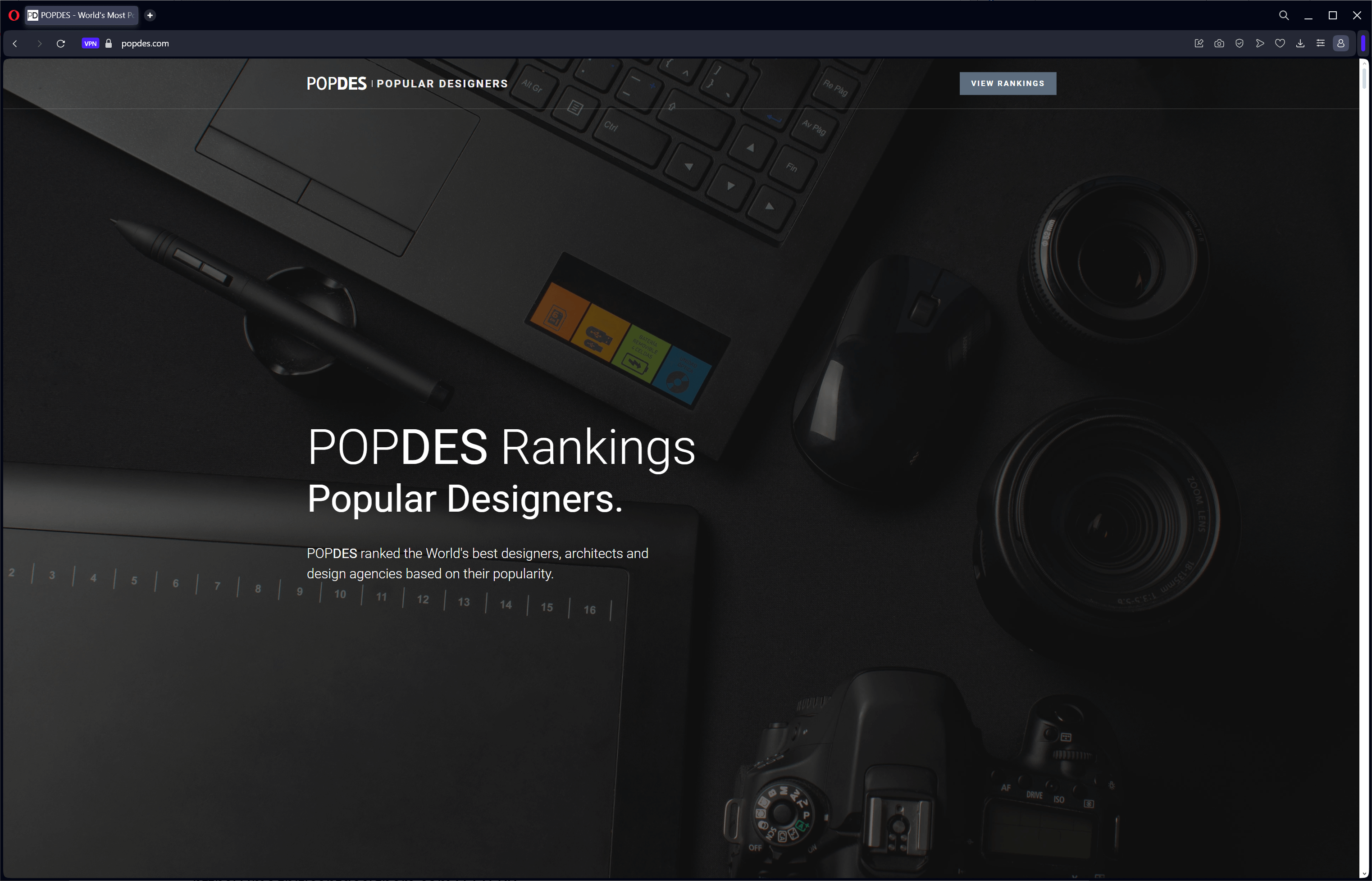
Popular Designers Certificates and Infographics
A' Design Awards offers free POPDES rankings certificates and infographics, providing a valuable service that acknowledges design achievements and promotes recognition. These professionally crafted materials serve as tangible proof of your accomplishment, validating your rank on POPDES and showcasing your standing among top global designers. The easily shareable infographics are great tools for digital communication, promoting your accomplishment on various platforms. Adding credibility and reflecting the prestige of A' Design Awards and POPDES rankings, these materials strengthen your personal brand image, affirming your reputation as a top designer. With an aesthetic appeal that mirrors the essence of design, these resources not only visually celebrate achievement but also elevate your professional standing, enhance personal branding, and contribute to marketing and promotional efforts.
POPDES Inclusion Benefits
Embrace your achievement and let the world know: your POPDES certificate and infographic are catalysts to spotlight your design prowess, remember to use your POPDES ranking to your benefit as a designer and aim for the following benefits and externalities:
- Reputation Enhancement:
Being ranked on POPDES signifies that a designer or brand is popular and highly sought-after. This enhances their reputation and brand image. Being ranked on POPDES confers a form of social proof, a psychological and social phenomenon where people follow the actions of others under the assumption that those actions are indicative of correct behavior. This helps to validate the credibility and talent of the designers, leading to enhanced reputation and brand image. Moreover, the Matthew effect, a concept from sociology, suggests that those who start with an advantage in certain areas can accumulate more advantages, making them more successful.
- Attracting New Clients:
A high POPDES score can attract potential clients, indicating that the designer or architect is popular and renowned, and thus a good choice for high-quality design work. Especially because A high POPDES score acts as a signaling mechanism in economics, representing quality. Potential clients viewing the ranking would use this information to make their decision, assuming that a higher ranking equates to better design skills.
- Pricing Power:
Designers with high POPDES scores can potentially charge higher fees for their services due to increased demand and reputation. Many companies would prefer to work with famous designers as it brings media placements, this can lead to increase in demand. Based on the law of supply and demand, a designer with a high POPDES score could charge higher fees. This is due to the increased demand for their services, which allows them to command a higher price point.
- Networking Opportunities:
The visibility provided by POPDES can help designers and architects connect with others in their field, facilitating collaborations and partnerships. The visibility provided by POPDES can lead to increased opportunities for network externalities, where the value of a product or service increases according to the number of others using it. In this case, other designers or firms may seek collaborations or partnerships with high-ranking designers, increasing the value derived from their network.
- Publicity:
Being featured on the platform can lead to increased media attention, offering free publicity and thereby expanding their audience. The mere exposure effect, a psychological phenomenon, suggests that people develop a preference for things merely because they are familiar with them. By being featured on POPDES, designers gain exposure, leading to increased familiarity and preference among potential clients or employers.
- Investor Attraction:
For businesses or designers seeking investment, a high POPDES score can serve as a validation of their value proposition and market potential. Indeed, the POPDES score can be seen as a form of intangible asset or reputational capital. Investors look for indicators of potential success, and a high ranking on such a platform signals strong prospects, making the designer or architect a more attractive investment opportunity.
- Brand Endorsements:
Brands could partner with top designers from POPDES for endorsements or collaborations, increasing their reach and sales. In detail, brands could leverage the halo effect, where the perception of positivity in one area influences the perception in another. By partnering with top designers from POPDES, brands can associate themselves with the designers' success and popularity, enhancing their own image and sales.
- Market Validation:
A high ranking on POPDES signifies market acceptance and popularity, which can be leveraged in marketing and promotional materials. To be more precise, A high ranking designer on the POPDES network signals to the market that the designer's work is popular and widely accepted. This social validation can be a powerful marketing tool, strengthening the designer's appeal to potential clients or consumers.
- Talent Attraction:
Being highly ranked can attract skilled designers or architects looking for successful teams to join. Especially, according to the Attraction-Selection-Attrition (ASA) framework, organizations attract individuals who fit in with their environment. High rankings signal success, potentially attracting skilled designers looking to be part of a successful team.
- Crowdfunding Opportunities:
Designers could leverage their popularity on POPDES to launch crowdfunding campaigns for unique projects, with their high ranking serving as a trust factor. In detail, crowdfunding relies on the wisdom of crowds, where collective opinion is often superior to that of a single expert. Leveraging their POPDES popularity, designers can attract more potential backers, increasing the likelihood of successful crowdfunding campaigns.
- Influencer Status:
Designers with high POPDES scores could leverage their popularity to become social media influencers in design-related niches. More specifically, top POPDES designers could leverage their popularity to become influencers - people like following famous people, and thus famous designers. The influencer effect suggests that individuals can influence the behavior of others through their online presence, potentially allowing these designers to create new revenue streams through partnerships or sponsored content.
- Design Education:
Top designers could offer premium online courses or workshops, using their high ranking as a credibility factor to attract students. Indeed, the authority principle in social psychology suggests that people are more likely to follow advice or directions from someone seen as an authority. Top-ranked designers, seen as authorities in their field, could use this to their advantage by offering premium courses or workshops.
- Licensing Opportunities:
Designers could license their popular designs for merchandise or product collaborations, capitalizing on their high POPDES score. In detail, licensing can create additional revenue streams for famous designers. By leveraging their POPDES popularity, they could attract more potential licensing partners, increasing their income.
POPDES - Popular Designers Index Methodology
Unlike award level based rankings (World Design Rankings, Designer Rankings and Design Classifications all sort designers based on the quantity and quality of awards won), the POPDES ranking sorting algorithm and its score is based on the number of press member views, designer profile views, design views, likes and interests by other users. Therefore the POPDES rankings show the most popular designers; it is a ranking of famous designers. Working with top POPDES designers can help establish and promote your brand value as a company. Popular Designers Index deviates from our purely meritocratic indexing methods as the POPDES algorithm is further affected by impressions, visualizations, search volume and trends. Popular Designers Index shall too be considered meritocratic from the perspective that better designs as well as better marketed designs would naturally gain more impressions, and knowing which designers are more popular and which designers are great marketers may be relevant to interested parties such as companies looking to co-brand with successful designers with a hope to increase their market reach and sales. The public designer popularity rankings are updated every year two times.
By promoting exceptional designers via the Popular Designers platform, the A' Design Prize significantly contributes to a global appreciation of good design. This platform's inclusion as part of the A' Design Prize helps to create a nurturing environment where good design flourishes. By championing these outstanding designers, the A' Design Award takes a significant step towards achieving its primary mission—making the world a better place through good design. This honor of showcasing and promoting top global designers is not only a responsibility but also a privilege we are proud to undertake.
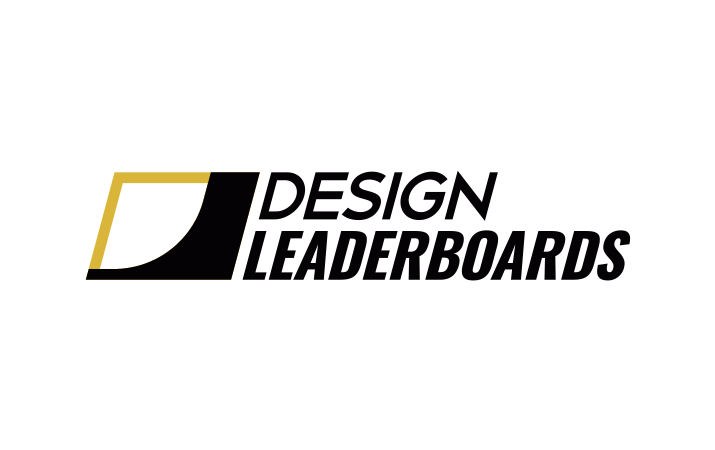 Design Leaderboards
Design Leaderboards
The Design Leaderboards is a dynamic ranking platform that rates and ranks designers based on their recent meritocratic achievements in the design field. Differing from traditional ranking systems that often emphasize lifetime achievements, the Design Leaderboards places more importance on recent success, applying an exponential function of time and growth of award scores to its ranking mechanism. This provides an up-to-date listing of leading designers, offering value to journalists, media companies, enterprises, and design-oriented businesses seeking to discover and engage with contemporary trendsetting creators and rising talents. The platform's recognition serves to amplify a designer's visibility, provides a competitive edge, and fosters networking opportunities. The Design Leaderboards, a merit-based and trend-sensitive platform, contributes significantly to a designer's professional growth, credibility, and overall market positioning. Learn about the design leader board algorithm and ranking mechanism at Design Leaderboards or access latest rankings at designleaderboards.com
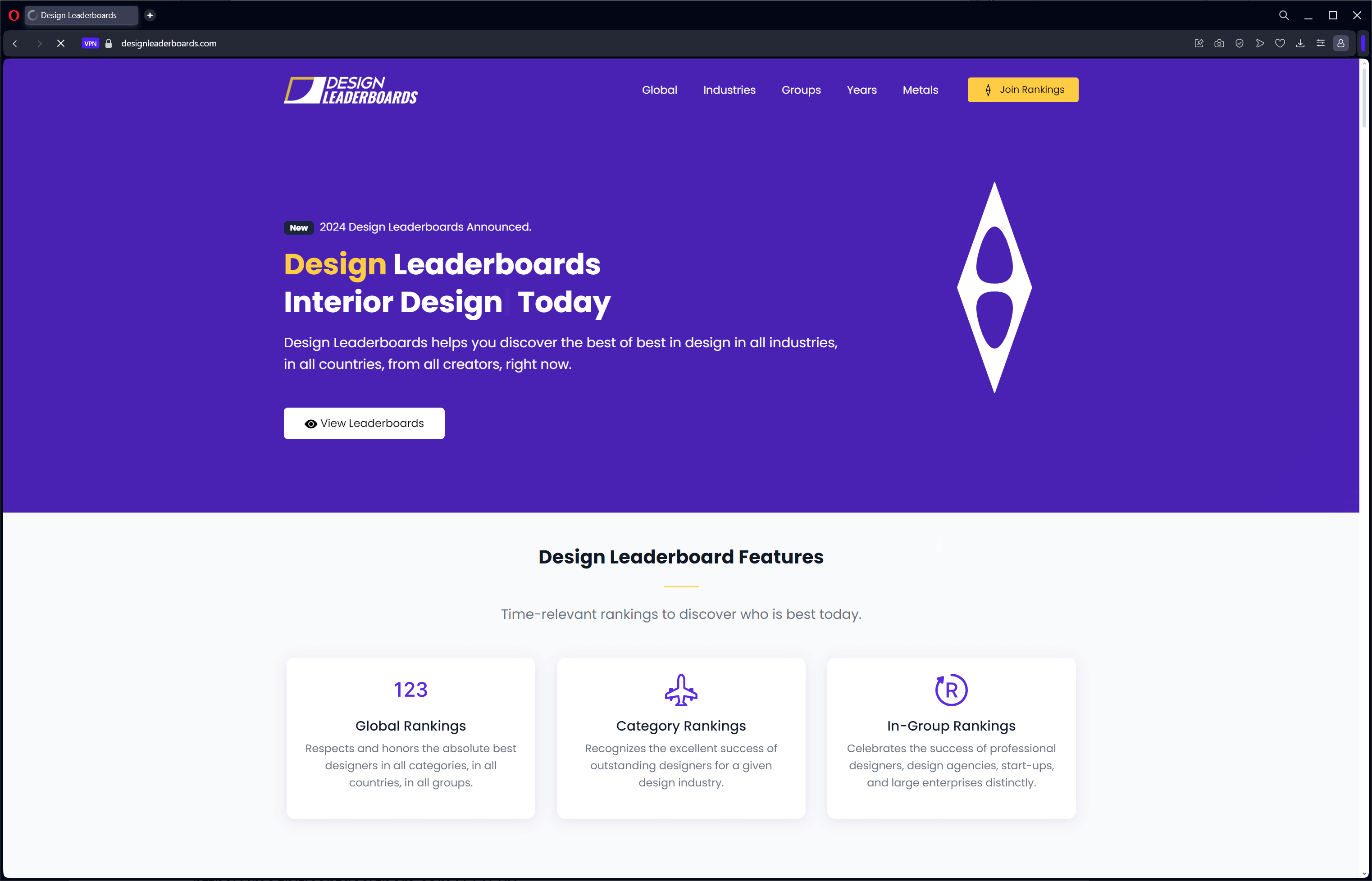
Design Leaderboard Certificates and Infographics
A' Design Awards, renowned for their highly-regarded recognition in the design field, offers its award winners complimentary certificates and infographics that illustrate their inclusion in the Design Leaderboards ranking platform. These visual tools provide an effective and engaging means to communicate a designer's recent accomplishments, enhancing their professional image and credibility. They serve as potent marketing assets, promoting the designer's relevance, proficiency, and success in the design industry. Widely shareable, these certificates and infographics increase the designer's visibility, potentially leading to new business opportunities, expanded networks, and an enhanced professional reputation. This free-of-charge service by A' Design Awards significantly enriches the value proposition for designers, aiding in effectively communicating their achievements and establishing a strong professional brand.
Design Leaderboards Inclusion Benefits
Inclusion in the Design Leaderboards provides award-winning brands and designers with a host of benefits. The platform enhances their visibility, allowing potential clients, customers, and media companies to easily discover their recent successes and achievements. It provides a competitive edge, demonstrating a brand or designer's current relevance and excellence in the design field. High rankings on the leaderboard can attract media attention, boosting exposure, and often lead to networking and collaboration opportunities with other professionals. Additionally, the leaderboard rankings bolster credibility and influence consumer decisions, as they associate high rankings with quality and success. High-ranking designers are likely to receive more job offers, and the focus on recent successes helps promote the designer's most current work. The Design Leaderboards thus serves as a dynamic tool for professional growth, market positioning, and business opportunities for brands and designers.
- Increased Exposure:
Being listed on the Design Leaderboards platform significantly amplifies a designer's visibility to potential clients, customers, and media companies. The platform acts as an advertisement showcasing their recent success. The Design Leaderboards serve as a highly specialized platform that is frequented by potential clients and media companies actively seeking talented designers. A high rank on such a platform is akin to a spotlight, bringing attention to the designers. This is related to the principle of scarcity in social psychology, where items or people in short supply are deemed more valuable. Here, being ranked among the top designers makes one more desirable and valuable.
- Competitive Advantage:
Design Leaderboard Rankings provide a competitive edge as they demonstrate recent success and relevance. They serve as proof of excellence and can be used to attract more business. Being highly ranked in Design Leaderboards indicates that a designer is currently excelling in their field. This recent success showcases their relevant skills and ability to produce quality work, differentiating them from competitors. This follows the economic concept of competitive advantage where firms distinguish themselves by offering superior quality or service.
- Attracts Media Attention:
Media outlets are always on the lookout for emerging talents or trends to feature. Design Leaderboards can serve as a source for them to find new, relevant personalities to feature, giving additional exposure to designers. A high rank on the Design Leaderboards shows a designer's recent success, making them a compelling subject for features or interviews. This media coverage then amplifies their exposure even further, an example of the snowball effect.
- Boosts Credibility:
Having a high Design Leaderboard Rankings bolsters a designer's reputation, making them more trustworthy and appealing to potential clients, customers, or employers. Ranking high on the Design Leaderboards suggests the designer's work has been evaluated and found to be of high quality by an impartial, respected platform. This third-party validation by the A' Design Awards, where entries are judged on by a grand jury panel, increases the perceived credibility and trustworthiness of the designer, a concept known as social proof in psychology.
- Networking Opportunities:
High-ranking designers attract attention from other professionals in their field, leading to networking and collaboration opportunities. High visibility often attracts like-minded professionals who value the designer's proven success. This could lead to collaborations or partnerships, contributing to a designer's professional growth. This follows the "network effect" in economics, where the value of a product or service increases as more people use it.
- Influences Consumer Decisions:
Seeing a designer ranked highly in Design Leaderboards can sway potential clients and customers. Consumers often rely on heuristics or mental shortcuts when making decisions. Clients often make decisions based on rankings and reviews. Seeing a designer ranked highly in the Design Leaderboards can influence the decision-making process of clients, consumers and customers, as they associate high rankings with quality and success. This heuristic is known as the authority bias.
- Better Job Opportunities:
High-ranking designers in the Design Leaderboards are likely to receive more and better job offers, enhancing their career progression. Employers prefer candidates who can demonstrate their capabilities. Being ranked highly on the Design Leaderboards platform can serve as strong evidence of a designer's competence, leading to more and better job offers. This is an example of signaling theory, where employers interpret high rankings as a positive signal of a designer's abilities, and indeed since the Design Leaderboards rankings are meritocratic, high-rankings do very often match with high capability.
- Promotion of Recent Work:
The Design Leaderboards platform focuses on recent successes, helping promote the designer's most current work and ideas, which may be more aligned with contemporary design trends. The platform's focus on recent successes means it highlights a designer's current work. This ensures that the showcased work aligns with contemporary design trends, making it more relevant and attractive to potential clients and consumers.
- Attract Investors:
High rankings in the Design Leaderboards can catch the eye of investors who are looking for successful designers or firms to invest in. High Design Leaderboards rankings can indicate a successful, innovative designer or design firm. Investors, always on the lookout for successful ventures, may view these rankings as a strong potential for return on investment. This decision-making process can be tied back to risk analysis in economics.
- Social Proof:
The high ranking in the Design Leaderboards acts as social proof, psychologically influencing potential customers to trust the designer more due to their validation by an authoritative platform. The ranking on the leaderboard serves as social proof, which is a powerful tool in influencing behavior. When potential customers see a designer's high rank, they perceive them as a safe and popular choice, increasing their likelihood to engage with them.
- Influencer Status:
Designers High-ranking in the Design Leaderboards could leverage their rankings to gain influencer status on social media platforms, extending their reach and impact. High-ranking designers could use their Design Leaderboards ranking status to become influencers on social media platforms, turning their expertise into content that can attract a broad audience. This taps into the power of social media marketing, where personality and personal branding play a big role in attracting and influencing followers. Being a recognized leader in their field would give their opinions and recommendations considerable weight, leading to opportunities for monetizing their influence.
- Mentorship Opportunities:
High-ranking designers could offer mentorship programs, using their status as a selling point to attract aspiring designers for mentorship programs, workshops, courses and classes. By showcasing their Design Leaderboards rankings, award-winners can establish themselves as successful and knowledgeable professionals in the field. This taps into the principle of authority, where people tend to follow the lead of real experts.
- Competitive Pricing:
A high ranking on the Design Leaderboards could also justify a designer's pricing strategies. Clients would be more likely to pay a premium for design services offered by a top-ranked designer because they associate this ranking with high quality and value for money. This is closely related to the economic concept of perceived value, where customers are willing to pay more for a product or service they believe offers greater benefits.
- Increased Client Trust:
Seeing a designer ranked highly on the Design Leaderboards instills a sense of trust in potential clients. This is because a high rank on the leaderboard signals that the designer's work has been validated by a recognized authority in the design industry. It reassures clients that the designer is capable of delivering high-quality work, reducing the perceived risk involved in hiring them. This is an application of risk perception and risk management principles in psychology and economics.
- Personal Branding:
A high-ranking designer on the Design Leaderboards can leverage this achievement to strengthen their personal brand. This helps in crafting a strong brand identity and narrative, underscoring their expertise, quality of work, and recent successes. A strong personal brand can be a powerful asset in the design industry, helping to attract clients, collaborators, and media attention.
- Leverage for Negotiation:
Having a high rank on the Design Leaderboards gives designers an edge during negotiations, whether for salaries, project fees, or contracts. It serves as proof of their recent success and competency, giving them leverage to negotiate better terms and conditions. This is an example of bargaining power, a concept in negotiation and conflict resolution.
- Heightened Perceived Value:
Being ranked high on the Design Leaderboards increases the perceived value of a designer's work. This is based on the psychological principle of social comparison, where people's opinions are influenced by comparisons with others. In this case, a high rank signifies that a designer's work is superior to those ranked lower, boosting the perceived value and desirability of their services.
Design Leaderboards Methodology
Design Leaderboards is significantly different from existing popular ranking and rating systems used in design field, the Design Leaderboards ranks and rates the designers on their most recent success, instead of lifetime achievements or impressions. Design Leaderboard rankings and ratings are calculated by giving a heavier weight on meritocratic achievements in the recent years, while giving less weight on meritocratic achievements in past years; the ratings mechanism gives more importance to recent success and less emphasis on past success to provide you with a list of current leaders of the design world, helping you find recently successful designers. Design Leaderboards helps journalists, media companies, large enterprises, and design-oriented businesses discover, feature, connect and hire trendsetting creators, rising designers, star architects and upcoming talents, that are recently on the rise. Design Leaderboards ranking mechanism is affected by an exponential function of time, as well as exponential growth of award scores. Design Leaderboards also provide further valuable information such as if the ranked entity is a design agency, a design-oriented enterprise, a design professional or a young designer, the number of awards the designer has won in different awards categories, and the total number of impressions the designer has received as of the moment the rankings were updated, as well as quantity and quality of awards won, and the years the awards were won. We have detailed documentation on Design Leaderboards here.
Through the innovative Design Leaderboards, the A' Design Award plays a crucial role in promoting outstanding designers who contribute to society with their superior products and projects. The Design Leaderboards, as part of the coveted A' Design Prize, amplify award-winners' visibility, demonstrating their current relevance and encouraging a global appreciation for good design. By promoting award-winners via the Design Leaderboards, we aim to nurture an environment where good design flourishes and outstanding designers are duly recognized. Our mission is to make the world a better place with good design, and we are honored to contribute to this mission by promoting excellent designers and their impactful works.
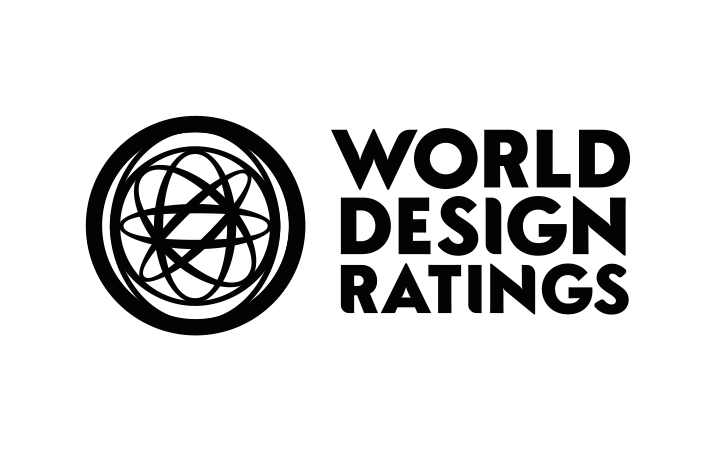 World Design Ratings
World Design Ratings
The World Design Ratings is a prestigious global ranking system that provides a snapshot of the design industry's state by recognizing, highlighting, and promoting good design, designers, and design-oriented companies worldwide. World Design Ratings is closely associated with the A' Design Award and Competition, an internationally renowned design accolade. Designers participating in the A' Design Award are granted a World Design Rating, which is assessed based on the quality and quantity of their awarded works. The World Design Ratings provides a tiered rating system and confers honorifics and title designations, acknowledging design competency and capabilities at varying levels. World Design Ratings serves as a valuable tool for designers to communicate their design excellence to clients, peers, and the broader design community. World Design Ratings' international scope offers participants visibility and exposure that can lead to diverse opportunities and advantages in their career. World Design Ratings is instrumental in setting standards and influencing trends in the design industry, driving creativity, innovation, and sustainable and ethical design practices globally. Designers are given a honorific designation as well as a WDC-Rank. World Design Ratings are published online at worlddesignratings.com
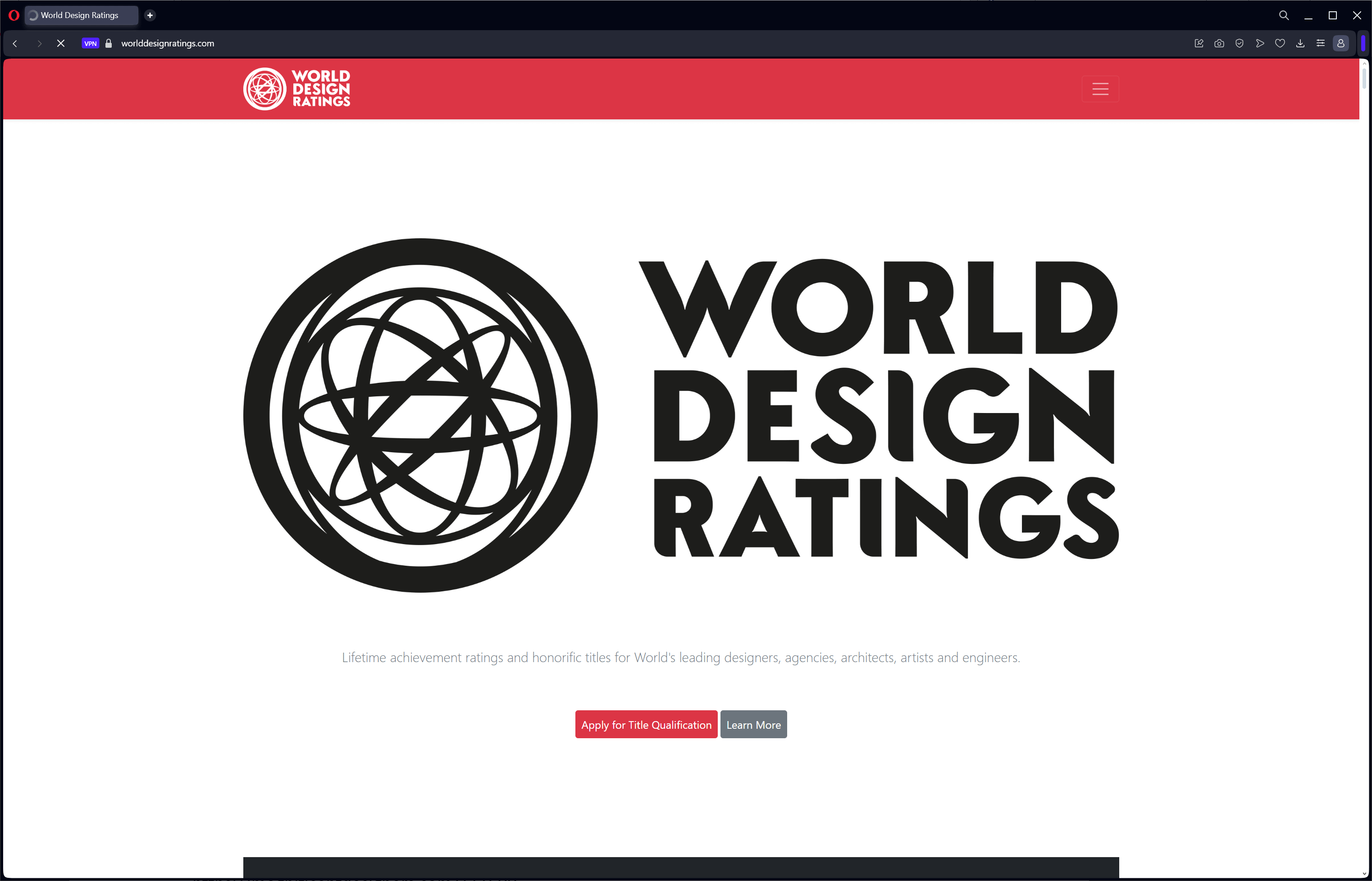
World Design Ratings Certificates and Infographics
The A' Design Award, through its affiliation with the World Design Ratings, not only confers recognition and prestige upon its winners but also equips them with tangible tools to leverage this acclaim in a professional setting. The provision of complimentary certificates and infographics to award winners underscores their accomplishment in a visually compelling and readily shareable manner. These assets serve as an effective means of communicating the winners' design competency and their placement within the global design landscape. They can be utilized in various promotional materials, professional portfolios, or online profiles, enhancing visibility and credibility. This tangible acknowledgment of their achievement is an invaluable tool for designers in establishing their professional reputation, differentiating themselves in a competitive marketplace, and securing new opportunities.
World Design Ratings Inclusion Benefits
Inclusion in the World Design Ratings platform provides award-winning brands, design agencies, and designers with substantial business benefits, primarily through enhanced credibility, visibility, and market differentiation. The assignment of World Design Consortium Ranks (WDC-Ranks) and designer honorifics serve as a testament to their design prowess and creative capacity, facilitating trust and confidence among potential clients and business partners. The acknowledgment on a global platform augments their professional reputation and provides extensive international exposure, thereby potentially expanding their client base. Additionally, the high-status recognition often attracts media attention, resulting in increased publicity and media placements. This can lead to additional opportunities for business growth and expansion. Overall, the recognition from the World Design Ratings platform provides a strategic advantage in the competitive design industry, serving as a powerful marketing and business development tool.
- Communicating Competency:
Designers can use their honorific title, designer rating, and WDC-Rank status to communicate their design competency and capabilities to potential clients, peers, and networks. This can help differentiate them in the market and aid in their professional progression. Marketing theory suggests that signaling can be an effective strategy for businesses and individuals to communicate their competency to the market. A designer honorific title, designer rating, and WDC-Rank status from the A' Design Award act as a signal that the designer is highly competent. This can help the designer differentiate themselves in a crowded market and potentially attract higher quality and higher-paying clients.
- Credibility and Trust:
Achieving a high World Design Rating and obtaining honorifics from a reputable platform can significantly boost a designer's credibility. Potential clients often feel more confident in choosing a designer who has been recognized by a trusted institution. The Principle of Authority, a well-known concept in psychology, states that people tend to obey authority figures. When a designer receives a high rating and honorifics from a reputable platform, it can significantly boost their authority in the field of design, leading to greater credibility and trust from potential clients and the wider design community.
- Visibility and Exposure:
The World Design Ratings platform increases a designer's visibility, especially on an international scale. High ratings can catch the attention of global brands and clients looking for top-notch design services. The platform's international nature and its recognition can exponentially increase a designer's visibility, applying the principle of the "Matthew Effect" as well as the "Snowball Effect". The global exposure can lead to new opportunities, potentially catching the attention of global brands and clients looking for top-notch design services.
- Endorsement Opportunities:
A highly-rated designer with a good World Design Ratings honorific might attract the attention of brands seeking to collaborate or associate their product with a recognized name in the design industry. These endorsement opportunities could provide additional income and exposure for the designer. Brands may seek to associate with a highly-rated designer to positively influence the perception of their products or services.
- Greater Market Reach:
The international exposure a designer gets from being highly rated on the World Design Ratings platform could enable them to expand their client base beyond their local market. The platform's international nature could help designers appeal to potential clients in other countries, thus enhancing their market reach. Through its international platform, World Design Ratings can help designers overcome geographical boundaries and extend their client base to an international market. This falls under the ambit of the economic concept of market expansion, which can potentially lead to a substantial increase in revenue and business growth.
- Attracting Investment:
For design firms, a high WDC-Rank rating could help attract investors who are interested in associating with a reputable and recognized name in the design industry. High WDC-Rank could signal that the firm is led by competent and innovative designers, potentially making the firm a more attractive investment proposition. Through its international platform, World Design Ratings can help designers overcome geographical boundaries and extend their client base to an international market. This falls under the ambit of the economic concept of market expansion, which can potentially lead to a substantial increase in revenue and business growth.
- Differentiation in the Market:
Designers can use their ratings and honorifics as a key differentiator in the market. It helps them stand out in the crowded design industry, highlighting their design competency and capabilities. The principle of Differentiation, a key concept in marketing, highlights the importance of standing out in a crowded market. The designer ratings and honorifics granted by World Design Ratings act as a unique selling proposition, allowing designers to distinguish themselves from their competitors.
- Improved Client Conversion:
The ratings and honorifics can act as a quality assurance to potential clients, thereby improving client conversion rates. In marketing, social proof is a powerful tool to persuade potential customers. High ratings and honorifics act as social proof, providing a quality assurance that can lead to improved client conversion rates.
- Publicity Opportunities:
Media outlets are more likely to feature highly rated designers within the World Design Ratings. This can lead to additional publicity and media coverage, further enhancing their visibility, this is because ,edia outlets are attracted to excellence. A high rating on a platform like World Design Ratings can act as a magnet for media attention, giving designers additional publicity and media coverage. This increased exposure can lead to additional opportunities and client leads.
- Elevated Brand Perception:
A high rating can elevate the perception of a designer's brand. Clients often associate quality and exclusivity with such recognition. Brand Equity is a marketing term that describes a brand's value, which is determined by consumer attitudes towards positive brand attributes. A high World Design Rating can elevate the perception of a designer's brand, adding to its equity.
- Influence on Pricing:
With a recognized status by the World Design Ratings, designers could have the ability to command higher fees for their services, as their work is deemed superior. Brand Equity is a marketing term that describes a brand's value, which is determined by consumer attitudes towards positive brand attributes. A high rating can elevate the perception of a designer's brand, adding to its equity.
- Networking Opportunities:
High ratings can open up opportunities to network with other top-rated designers and potential clients at award ceremonies or other related events. The principle of birds of a feather flock together suggests that similar individuals tend to associate with each other. High ratings can enable designers to network with other top-rated designers and potential clients at award ceremonies or other related events.
- Motivation and Employee Morale:
For design firms, having a high World Design Rating status and WDC-Rank can boost employee morale and motivate the team to strive for continual excellence. The Expectancy Theory of Motivation suggests that employees are motivated to perform better when they expect that their increased performance will lead to good performance appraisals. For design firms, a high rating can act as a performance appraisal, leading to increased motivation and employee morale.
- Influence on Design Trends:
Highly rated designers with good World Design Rating standings and high WDC-Rank status could influence trends in the design industry. Highly rated designers, due to their visibility and credibility, could influence trends in the design industry, a phenomenon aligned with the theory of Diffusion of Innovation.
- R&D Opportunities:
For design firms or individual designers, high World Design Rating score might attract offers for research and development collaborations with other companies or educational institutions. This can lead to further innovation and diversification of their design portfolio. The economic concept of Collaborative Advantage suggests that partnerships can lead to innovation and diversified portfolios.
- Promotion of Sustainable and Ethical Design Practices:
Highly-rated designers within the World Design Ratings have a platform to showcase and promote sustainable and ethical designs. Their high visibility can influence other designers and companies to adopt these practices. The concept of Corporate Social Responsibility (CSR) applies here. Highly-rated designers have a platform to showcase and promote sustainable and ethical designs, thereby contributing to their CSR initiatives and influencing others in the industry to do the same.
- Policy Influence and Standard Setting:
The prestige associated with a high rating can offer designers an opportunity to participate in policy discussions and standard setting in the design industry. They can influence industry norms and push for standards that benefit the design community as a whole. The power of Influence, a fundamental concept in social psychology, applies here. High ratings can provide designers with the platform to influence industry norms and push for standards that benefit the design community as a whole.
- Recognition and Validation:
Participating in the A' Design Award and Competition allows designers to receive recognition for their work via World Design Rating honorifics and title designations. The higher the quality and quantity of their work, the higher the award status they can achieve. Such recognition and the accompanying titles or honorifics serve as an affirmation of their design competency and capabilities. The recognition from a reputable entity such as World Design Ratings provides the designer with an affirmation that their design capabilities and competency are of high standard.
World Design Ratings Methodology
Designer ratings, titles and honorifics are given to award-winning designers, artists, architects, innovators and creators who showcase and prove their excellent design tenets and capabilities with their award-winning works year after year, we have a dedicated page that explains the World Design Ratings platform.
The inclusion of World Design Ratings as part of the A' Design Prize is instrumental in highlighting the role of outstanding designers and their impact on society. It not only offers recognition to these talented individuals but also serves as a platform to promote good design practices. This creates a nurturing environment where good design can flourish and be appreciated worldwide. We believe that promoting award-winners via World Design Ratings helps us fulfill our primary mission of making the world a better place with good design. We take pride in this endeavor and are committed to celebrating and supporting the designers who bring about change through their exceptional work.
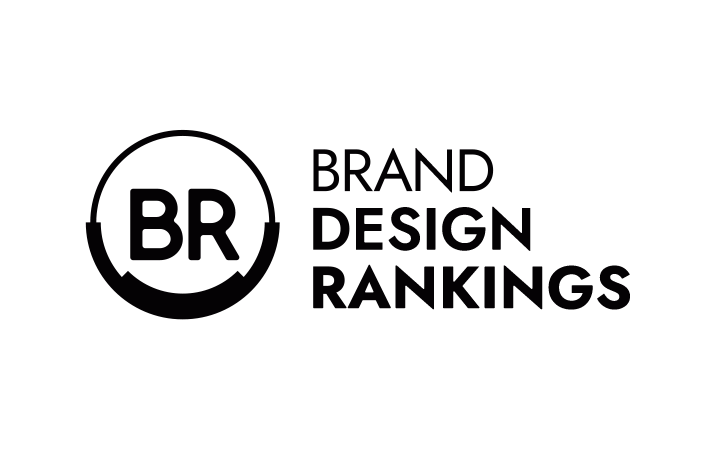
Brand Design Rankings
Brand Design Rankings is a globally recognized, meritocratic platform that ranks brands based on their design excellence and innovation. The rankings are derived from the number of award-winning works in the juried A' Design Awards, following a blind peer-review process with an esteemed grand jury panel. The platform encompasses Global and Industry Achievements, promoting visibility and recognition for brands across various industries worldwide. Utilizing a transparent scoring algorithm, the Brand Design Rankings not only offer a competitive benchmark for brands but also serve as a valuable resource for consumers, media, and potential partners to identify and engage with the leading brands in design and innovation. Brand Design Rankings are published online at branddesignrankings.com
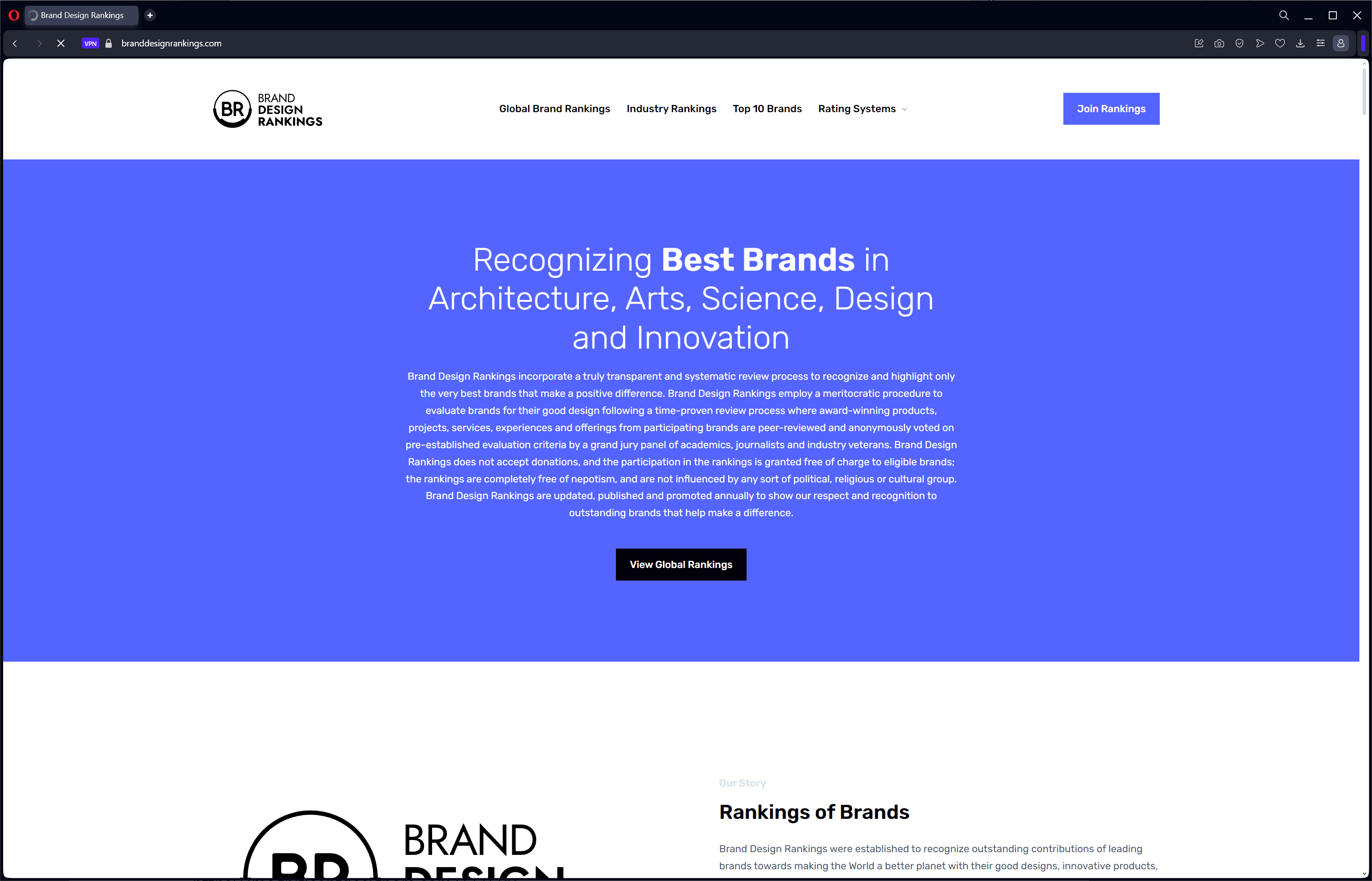
Brand Design Ranking Certificates and Infographics
Inclusion in the Brand Design Rankings provides brands with a multitude of strategic benefits. From a business perspective, it can enhance a brand's credibility and reputation in the global market, boosting customer confidence and potentially leading to increased sales. Being listed among the top design-centric brands can set a brand apart from its competitors, facilitating product differentiation and fostering a culture of innovation. This can also attract skilled talent, potential investors, and strategic partners. From a media exposure standpoint, the ranking acts as a newsworthy achievement, increasing the likelihood of media attention and coverage, which can further amplify the brand's visibility. The recognition can be leveraged in marketing and public relations campaigns, reinforcing the brand's commitment to design excellence and innovation. All these benefits can contribute to the brand's long-term growth and sustainability.
Brand Design Rankings Inclusion Benefits
A' Design Award and Competition provides Brand Design Rankings Certificate and Infographics to eligible brands, free of charge. The provision of free certificates and infographics by A' Design Awards to the winner brands is an invaluable service that can boost their marketing and public relations efforts. By leveraging these visually engaging and easily shareable infographics, brands can enhance their visibility, reinforce their design credentials, and create compelling narratives around their success. These documents serve as powerful tools to build credibility, foster trust, and amplify their brand's reputation in a competitive market.
- Increased Visibility and Recognition:
Being included in the Brand Design Rankings can significantly increase a brand's visibility and reputation in the global market. This can lead to broader recognition and attract potential customers or clients. When a brand is listed in the Brand Design Rankings, it gets global exposure. The rankings are open to access by a wide range of stakeholders - from consumers, potential business partners, to investors, which directly leads to increased brand visibility.
- Enhanced Brand Image:
Winning an award and getting a high rank can on Brand Design Rankings can help improve the brand's image by associating it with excellence and innovation, which can be very appealing to customers and partners alike. A brand's image is its perceived value in the minds of its customers. By winning an award and getting a high rank on Brand Design Rankings, a brand sends a signal about its commitment to quality, innovation, and excellence.
- Marketing Leverage:
Brands can use the recognition from the Brand Design Rankings in their marketing campaigns to emphasize their design excellence and commitment to innovation. Recognition from Brand Design Rankings can be a powerful marketing tool. Brands can use it in their advertising and promotional materials to highlight their commitment to design excellence. The 'Authority Principle' in psychology implies that people tend to obey authority figures. Being recognized by a reputed authority like Brand Design Rankings can make marketing claims more credible and persuasive.
- Attracting Potential Partnerships:
High Brand Design Rankings status may attract potential partners, investors, or collaborators who are looking for successful, innovative brands to work with. In the business world, success attracts success. High-ranking brands signal their ability to create innovative designs and offer value, making them attractive to potential partners. This is related to the concept of 'brand equity' in marketing - the added value that a brand name gives to a product or service. Higher brand equity can increase the chances of successful collaborations or partnerships.
- Sales Increase:
With the increased visibility and credibility thanks to Brand Design Rankings, the brands may experience a boost in their sales as customers are more likely to trust and choose award-winning products or services. Trust plays a crucial role in customers' purchase decisions. Recognition from Brand Design Rankings can increase a brand's credibility, as it acts as a form of 'third-party endorsement.' This can alleviate customers' perceived risk and may lead to increased sales - a phenomenon related to the 'Halo Effect', where the perception of one positive attribute (award-winning design) extends to other aspects of the brand.
- Customer Retention:
Existing customers may feel more confident about their choice and stay loyal to a brand that is recognized for its design excellence and included in the Brand Design Rankings. Existing customers of a brand may feel validated about their choice when the brand is recognized for its design excellence. The 'Confirmation Bias' in psychology suggests that people love to have their existing beliefs confirmed. Thus, this recognition may strengthen brand loyalty and customer retention.
- Employee Motivation:
Achieving a high rank in Brand Design Rankings can boost morale within the company, creating a positive work environment and encouraging employees to maintain the high level of design quality. Achieving high rank can serve as a source of motivation for employees. This aligns with the 'Self-Determination Theory' in psychology, which states that people are more motivated when they feel that they are contributing to success. This recognition validates their efforts and may enhance job satisfaction and productivity.
- Setting a Benchmark in Industry:
By receiving high Brand Design Rankings status, the brand sets a standard of excellence within their industry, motivating competitors to match or exceed their accomplishments. High-ranking brands can influence industry standards. This can lead to a 'Trickle-Down Effect', where the commitment to design excellence demonstrated by leading brands can influence the practices of other brands in the industry.
- Media Exposure:
High-ranking brands within the Brand Design Rankings may attract attention from media outlets, leading to press coverage that can further increase their visibility and reputation. Having a high Brand Design Rankings also sets stage for communicating with the media. Media outlets are more likely to cover high-ranking brands as they provide valuable content for their audience. This can lead to a 'Virtuous Cycle', where media coverage further enhances brand visibility, which in turn attracts more media attention.
- Global Networking Opportunities:
Brands can connect with other award-winning designers, brands, and industry leaders, opening up opportunities for collaboration and knowledge exchange. In today's interconnected world, networking is critical for business growth. High-ranking brands can attract attention from other industry leaders, fostering valuable connections. This aligns with the 'Network Effect' principle, which suggests that the value of a product or service increases with the number of others using it.
- Cultural Influence:
Brands with good design, listed at Brand Design Rankings, can influence cultural trends, shaping aesthetics and consumer behavior in their industry and beyond. Brands often play a significant role in shaping cultural trends and consumer behaviors. Recognition on the Brand Design Rankings highlights the brand as a leader in design and innovation, setting a standard others might follow. This phenomenon is related to the 'Cultural Transmission' theory, which discusses how cultural norms, ideas, and behaviors are passed within and among social groups.
- CSR Opportunities:
By aligning their brand with design excellence, and getting listed at Brand Design Rankings for their good design, companies can promote Corporate Social Responsibility (CSR) initiatives that focus on sustainable and responsible design practices. Aligning a brand with design excellence opens opportunities for demonstrating Corporate Social Responsibility (CSR) - a business's self-regulated contribution to societal goals. The 'Social Exchange Theory' in psychology suggests that mutual benefit enhances relationship quality. In this context, brands engaging in CSR initiatives can strengthen customer loyalty and improve brand image.
- Attraction of Talent:
Having a high rank in the Brand Design Rankings can attract skilled and talented individuals who are eager to work with a highly recognized brand. This can help the company to not only maintain its standards of excellence but also foster innovation by bringing fresh perspectives into the team. Excellence attracts excellence. By achieving a high rank in the Brand Design Rankings, a brand can position itself as an attractive workplace for ambitious, talented individuals who value design and innovation. This is linked to the 'Attraction-Selection-Attrition' framework in organizational psychology, which posits that organizations and employees are drawn to each other based on shared characteristics or goals.
- Facilitation of Product Differentiation:
High recognition in Brand Design Rankings could serve as a key differentiator in crowded marketplaces. It could help consumers easily identify and select the brand over competitors due to its established design prowess. In crowded marketplaces, brand recognition in Brand Design Rankings can help in distinguishing a brand from its competitors. This creates a 'Unique Selling Proposition' (USP), a marketing concept that identifies the unique benefits a product or service provides compared to its competitors.
- Encouragement of Innovation:
The desire for brands to maintain or improve their Brand Design Rankings could encourage companies to continuously innovate. This culture of innovation could lead to the creation of more unique, high-quality products and services that appeal to consumers. Brands striving to maintain or improve their Brand Design Rankings position are encouraged to innovate. This aligns with 'Innovation Diffusion Theory', which describes how new ideas and technology spread through cultures. Brands that consistently innovate may drive industry trends, creating unique, high-quality products and services that consumers desire.
- Increase in Investor Confidence:
A high rank in the Brand Design Rankings can boost investor confidence. It indicates the brand's competency in design and innovation, which are vital factors for growth and sustainability, thereby making it an attractive investment proposition. High rank in the Brand Design Rankings signifies a brand's design competency and commitment to innovation, both crucial for growth and sustainability. This connects to the 'Signaling Theory' in economics, which suggests that certain activities or attributes (like high Brand Design Rankings) signal a higher quality or reliability to potential investors, boosting their confidence in the brand.
- Opportunities for Licensing and Collaboration:
Brands that achieve high rankings in Brand Design Rankings could attract proposals for licensing their designs or forming strategic partnerships. These collaborations could provide additional revenue streams and promote further growth for the company. Highly ranked brands might attract licensing proposals or partnership opportunities. This can create additional revenue streams and growth potential, relating to the 'Resource-Based View' theory in strategic management that asserts companies gain a competitive advantage by maximizing their different resources.
Brand Design Rankings Methodology
The calculation of Brand Design Rankings is based on a transparent and meritocratic algorithm. Each A' Design Award tier is assigned a specific value, and the number of awards a brand wins in a given year is multiplied by this value. This calculation is further adjusted by a year-dependent multiplier, which assigns greater importance to more recent achievements, creating an exponential falloff curve. The final score for each brand is the sum of these adjusted award values over the years. This score then determines the brand's position in the global rankings and within their specific industry. This intricate yet transparent methodology ensures that the rankings truly reflect a brand's consistent commitment to design excellence and innovation over time. We have a detailed and dedicated page that gives you more details on Brand Design Rankings, Brand Design Ranking Certificates and Infographics.
Through the Brand Design Rankings, A' Design Award winners garner global acclaim, strengthening their market presence and creating a ripple effect of inspiring good design practices. This recognition not only reaffirms our mission of making the world a better place through good design but also resonates with our objective of promoting talented designers whose remarkable products and projects uplift society. By spotlighting award-winners via Brand Design Rankings, we aim to foster a global understanding and demand for good design, creating a nurturing environment for good design to flourish. The promotion of good designers and design practices is core to our mission, and we take immense pride in this endeavor.
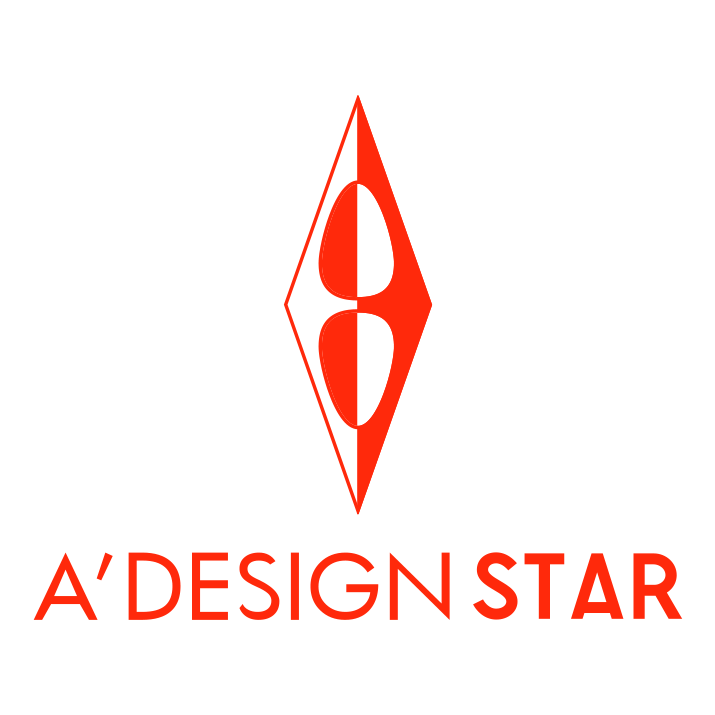
A' Design Star Designation
The A' Design Star is a prestigious designation awarded to architects, designers, and creative agencies that demonstrate excellence and consistency in their design work over a period of time, designers must win 3 years in a row to have their A' Design Star rating and designation assigned. Unlike the A' Design Award, which is awarded to individual works, the A' Design Star is bestowed upon the designer or agency themselves, endorsing and certifying them as institutions of design excellence.
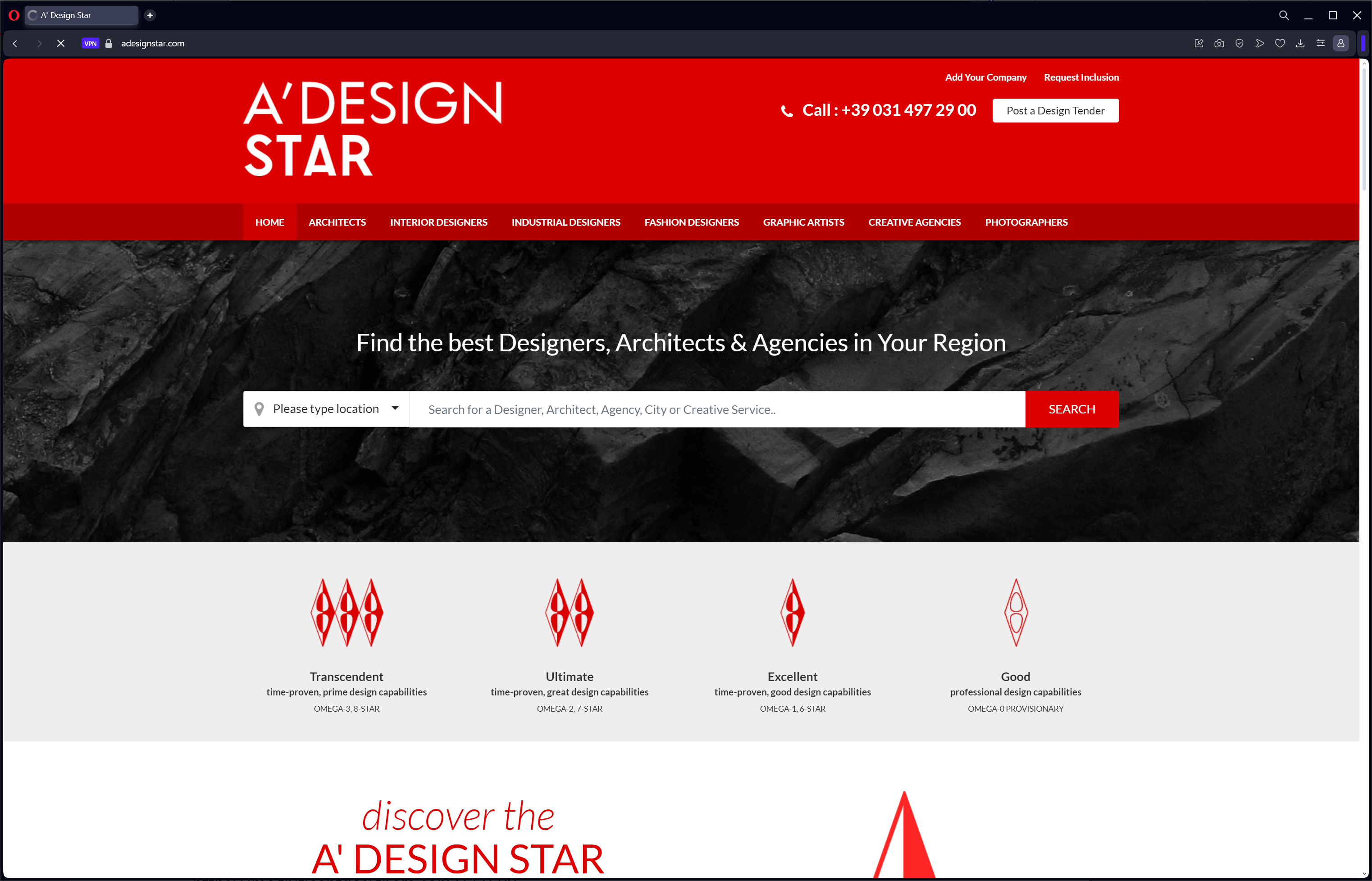
A' Design Star Emblem
The A' Design Star Emblem is a visual symbol that can be used by the recipients of the A' Design Star designation to signify their achievement. It serves as a mark of distinction and a promise of consistent, high-quality design work over the years, given for repeat success.
A' Design Star Wall Sign
A' Design Star Wall Sign is a physical sign that can be placed in a prominent location in a designer or agency's office. The sign acts as a continuous reminder to clients and visitors of the organization's commitment to excellence and its recognized achievement in the design field.
A' Design Star Communication
A' Design Star Communication is a press release template that can be customized and sent to press contacts. It provides an effective way to communicate the achievement of receiving the A' Design Star designation, and can also be adapted for use on websites or social media platforms.
A' Design Star Guide Inclusion
A' Design Star Guide Inclusion refers to the inclusion of the recipient's information in the A' Design Star Guide, a reference book that serves as a tool for potential clients looking for highly rated designers or agencies. Being included in the guide enhances visibility and reputation among potential clients and peers in the design industry. Access the A' Design Star guide at adesignstar.com
A' Design Star Benefits
The A' Design Star designation serves as a potent endorsement of design excellence and consistency, catalyzing numerous business benefits. It amplifies brand recognition and provides enhanced marketing opportunities, leveraging social proof to foster consumer trust and credibility. This recognition empowers businesses with increased pricing power, enabling premium rates due to elevated perceived value. It bolsters brand equity and opens avenues for global exposure, promoting diversity and risk mitigation. The A' Design Star also signals quality, reducing information asymmetry and attracting funding by lowering perceived investor risk. Moreover, it attracts top talent, fostering a high-performing work environment. In essence, the A' Design Star acts as a catalyst for business growth, market expansion, and value creation.
- Amplified Recognition and Visibility:
Obtaining the A' Design Star enhances the prestige and visibility of your brand, making it stand out in the crowded market and invoking the halo effect. This implies that potential clients and partners will perceive all aspects of your business positively. The "halo effect" suggests that we tend to assume that if something is good in one area, it's likely to be good in other areas as well.
- Enhanced Marketing Opportunities:
The A' Design Star can be a powerful tool in your marketing arsenal, allowing you to utilize the concept of "social proof." By displaying this prestigious recognition, you create an impression of reliability and credibility, which could be used to influence leads and prospective clients and consumers, especially communicating the fact that you deliver consistent good design.
- Increased Pricing Power:
Economic theory suggests that higher perceived value can justify higher pricing. With the A' Design Star, your work, your design capacity and quality is clearly distinguished as superior, which could allow you to command higher prices, boosting your overall revenue.
- Brand Equity Enhancement:
A' Design Star recognition can help to increase your brand equity – the intangible value derived from consumer perception of your brand. This value is often associated with brand recognition, reputation, and loyalty, and it can lead to competitive advantages and increased profitability in the long run.
- Networking Opportunities:
Being part of the A' Design Star community gives you access to high-level professionals within the industry. From an economics perspective, this provides opportunities to build valuable strategic partnerships, fostering business growth and potentially leading to synergies that could offer a competitive advantage.
- Communicating Design Quality:
By signaling your design competence, the A' Design Star reduces uncertainty and information asymmetry – a concept from economics where one party possesses more or better information than the other. By showcasing your recognition, you can bridge this gap, making it easier for potential clients to trust and understand your excellent, time-proven design abilities.
- Global Exposure:
The A' Design Star can open doors to international markets. Leveraging this global recognition can help to diversify your client base, spreading risk, and increasing the potential for revenue growth. A' Design Award provides you with A' Design Star inclusion, press releases and tools to help you with your global exposure.
- Increased Market Value:
For design, engineering and architectural services, the A' Design Star acts as a quality signal, improving your negotiation power. By enhancing your brand's perceived value for consistent good design, you can command higher prices, increase market share, and enhance your overall market value.
- Credibility for Funding and Investments:
From an investor's perspective, the A' Design Star reduces the perceived risk, as it demonstrates your consistent design quality and potential for success. This validation can increase the likelihood of securing funding, enabling further business growth and expansion.
- Attracting Talent:
From a human resources perspective, the A' Design Star can help attract top talent. The "attraction-selection-attrition" framework suggests that people are attracted to organizations that fit their personality. By showcasing your recognition, you can attract like-minded professionals who value excellence and are likely to contribute to the ongoing success of your firm.
A' Design Star Designation Methodology
The A' Design Star Designation is based on a rigorous assessment of a designer's or agency's work over three years. The evaluation considers not just the quality of the work, but also the consistency and repeatability of excellence in design output. The methodology uses a star-rating system, from Omega-0 to Omega-3, to classify the level of achievement, with Omega-3 representing the highest level of recognition. The star rating is attached to a specific branch or location of a design institution, emphasizing that the recognition is tied not just to the individuals, but to the broader institution's continued commitment to design excellence.
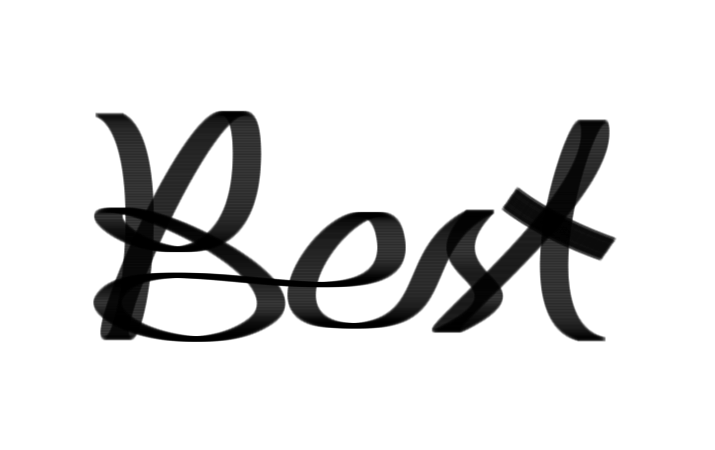 Best Designers
Best Designers
Another platform where winners are displayed based on their meritocratic achievements are called the "Best Designers", this platform is more or less equal to designer rankings platform, except that winner designers are displayed with their profile photos, together with a link to their profile at A' Design Awards. Inclusion is automated for all winners. Further information could be found and the updated rankings could be observed at bestdesigners.org
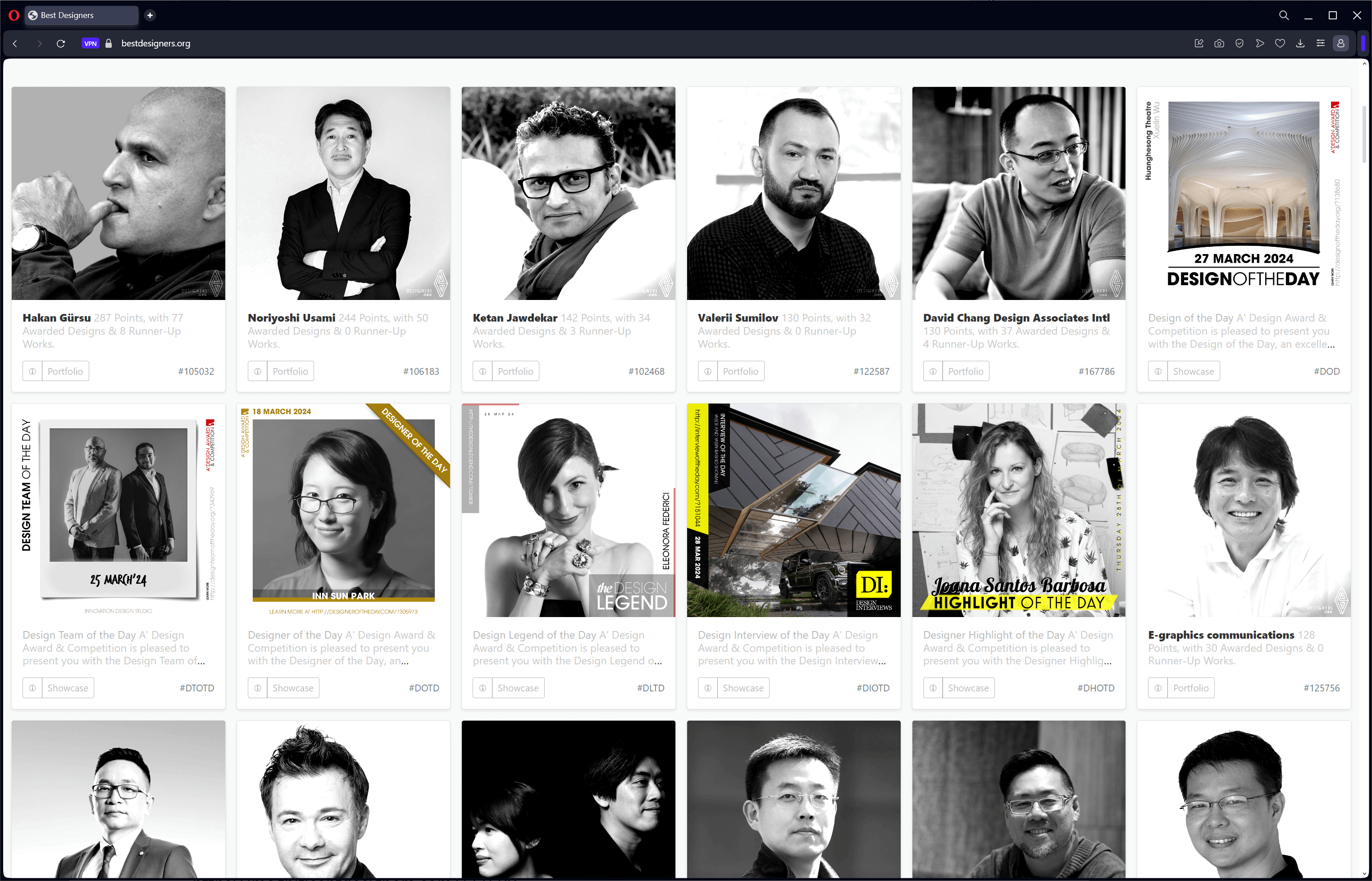
Design Award Winners List
The A' Design Award Winners List showcases winners of the latest design award, sorted by categories and sorted by award status; Platinum award winners are shown atop, followed by Gold, Silver, Bronze and Iron winners. The A' Design Award Winner’s List only shows winners of the last design competition but you can access past winners from our ranking and ratings websites going back to 2009.
How to Get Listed in All Design Rankings
To get included, enter and nominate your design for awards-consideration, if you are winner, you will join the leader boards. All winners are automatically placed in the all different design ranking, classification, rating and leaderboard platforms; you will be automatically included in the R+ Designer Rankings, Designer Ratings, Design Leaderboards, DAC - Design Classifications, POPDES - Popular Designers Index, Best Designers Website, A' Design Award Winners List and the World Design Rankings provided that your profile information is filled correctly. If a winner does not show-up on rankings they are advised to fill their profile completely.
Design Momentum Principle - 8 Years of Creative Reign
The "Design Momentum Principle" is an initiative we've instituted to maintain a current, dynamic representation of the design industry on the World Design Rankings, Designer Rankings and Design Classifications and Best Designers platforms. This rule ensures that only those designers who have received the A' Design Award within the past 8 years - a period selected to mirror the average product life cycle - are prominently featured in the rankings. The rationale is to highlight active participants in the design process, thereby encouraging continual innovation, fostering competitiveness, and providing a more engaging and relevant platform for design enthusiasts, potential clients, and future design talent. The introduction of the 8-year rule in the World Design Rankings, Designer Rankings, Design Classifications and Best Designer Platforms reflects our steadfast commitment to maintain a dynamic and relevant platform that truly mirrors the contemporary design industry. This change has been implemented with the aim of fostering a more competitive and active landscape that reflects the trends and innovation of today. Incorporating an 8-year window, analogous to an average product life cycle, adds a significant layer of value for both past and current award winners. For past laureates, this model enhances the prestige of their achievements, framing them not just as historic accomplishments but as significant influences that shaped design over recent years. For current and future winners, this system amplifies the visibility and impact of their triumphs, offering them an enriched platform to showcase their talent and creativity to potential clients, consumers, and industry peers. This modification is guided by the understanding that design is a living, evolving discipline. By centering the spotlight on designers who have won the A' Design Award within this 8-year timeframe, we aim to emphasize active contributors to the design process. This ensures that our rankings reflect the current state of design innovation and expertise, making them a more accurate and effective tool for identifying leading-edge talent. The new rule also seeks to incentivize continual innovation. Designers and brands are encouraged to consistently push the boundaries of their craft and submit their innovative works to vie for recognition in the updated rankings. For society at large, this provides a more authentic and engaging snapshot of the contemporary design scene. It allows consumers, clients, and design enthusiasts to engage with the forefront of design innovation and connect more closely with the creators who are actively shaping our world. The 8-year rule is a forward-thinking change aimed at promoting dynamism, relevancy, and competitiveness in design. It's a move that values consistent innovation and active participation, rewarding those who are at the forefront of shaping the design industry, while also honoring the lasting impact of past laureates.
Vanguard and Heritage Rankings
In order to capture the vibrancy of current design achievements while simultaneously honoring our past laureates, we've introduced a dual ranking system following our Design Momentum Principle: the "Vanguard Rankings" and "Heritage Rankings". This thoughtful approach values the evolving design world, and ensures we create a comprehensive reflection of the industry's full spectrum. The Vanguard Rankings focus on the trailblazers of design who have won the A' Design Award in the last 8 years. This echelon is designed to highlight the innovative and pioneering individuals who are actively propelling the design world forward. It provides current participants with a competitive platform to shine and be recognized by prospective clients, consumers, and peers in their field. Concurrently, our Heritage Rankings pay tribute to past laureates whose work continues to resonate even after the 8-year period. It ensures that past winners maintain their well-deserved recognition and accolades, while providing an inspiring resource for aspiring designers and the broader society to learn from the past and build upon it. For journalists, this two-tiered ranking system offers a rich and varied source of information, reflecting both the dynamic, ever-changing nature of the design field and its deep, influential roots. They can easily spotlight emerging trends and key players in the Vanguard Rankings, or delve into the Heritage Rankings to explore the long-lasting impact and legacy of past design triumphs. This dual structure, therefore, offers a more diverse and nuanced understanding of the design industry's past, present, and potential future.
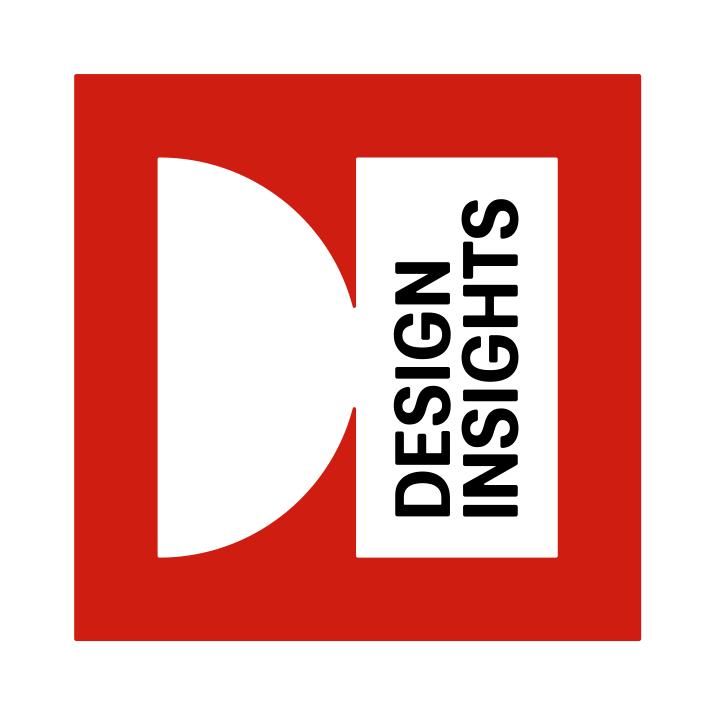
Design Insights
Design Insights is a comprehensive platform that evaluates and ranks countries based on their recent design, engineering, innovation, and technology capabilities. By analyzing the performance of designers, architects, brands, and manufacturers across various creative domains and industries, Design Insights provides a detailed overview of each country's strengths, mature capabilities, and areas of opportunity. The platform utilizes a rigorous methodology, including blind peer review and weighted scoring, to calculate these rankings and stratify them into three tiers: "Top Tier" for Rising Strengths, "Middle Tier" for Inherent Capabilities, and "Base Tier" for Opportunities. Design Insights covers a wide range of industries, from furniture and packaging design to architecture, fashion, and digital technologies, offering a holistic view of a country's design and innovation landscape. By encouraging participation in the prestigious A' Design Awards, Design Insights fosters individual and national growth in the creative sectors, highlighting the interconnectedness of personal achievements and national prestige in the global design community. Visit Design Insights to learn more.
What is the Ultimate Goal of Rankings and Rating Systems for Design?
Everything we do at the A' Design Awards, we do to achieve our mission of making the World a better place with good design. Ultimately, our goal with all our ranking and rating mechanisms for designs and designers is to incentivize the designers, the creatives, the innovators, the pioneers. It is hard to be a designer, artists or architect; creating a good design is a big investment, needs a lot of inspiration, time investment, sacrifice and creative energy; we know that recognizing, promoting, honouring and advertising great designers and their exceptional work incentivizes them to create new and better designs that eventually help and advance society; respecting designers, and showing them their work matters, is absolutely crucial for our mission, we believe the ranking and rating systems could be one the ways to push and ignite the designers to create better products, projects and services. A' Design Award’s ranking and rating systems, which are extensively promoted and advertised every year, helping designers get recognized, respected, honoured, and promoted eventually helps make the World a better place for all. Rankings and ratings helps us show our respect and love for good design, for great designers, and of course we also undertake many more tasks to achieve our noble goal, such as by means of organizing international design exhibitions, publishing good design yearbooks, creating and promoting design events, providing publicity services, and engaging in public awareness campaigns, within the scope of the much coveted A' Design Prize given to award-winning designers worldwide.

